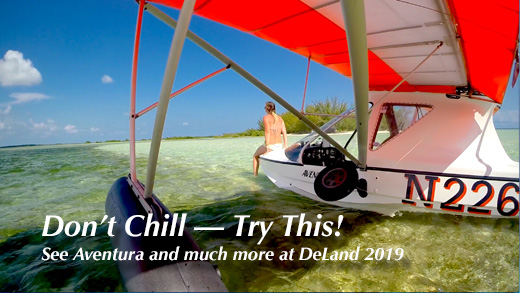
That was several hours of my life I will never get back — booking airline, rental car, and a series of hotel rooms… and then cancelling all of them! Drat! Yet my frustration in scuttling travel plans to attend and work Aero Friedrichshafen is minor compared to the effort by the people running Aero and the 700 vendors that all must now change their plans. Even noting this does not count the hundreds of small businesses from gas stations to restaurants to hotels and more that will suffer sharp revenue losses, possibly resulting in many jobs being terminated. What a mess! Not Just China’s Problem “As Head of Aero Friedrichshafen, I have experienced many situations during the last 30 years which have affected the global economy and the aerospace industry in a negative way,” started Roland Bosch, the longtime leader of this very popular European airshow. “But never before has an incident had such a strong impact on the global economy like the new coronavirus.


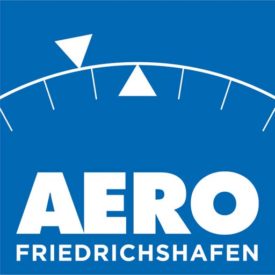 That was several hours of my life I will never get back — booking airline, rental car, and a series of hotel rooms… and then cancelling all of them! Drat!
Yet my frustration in scuttling travel plans to attend and work
That was several hours of my life I will never get back — booking airline, rental car, and a series of hotel rooms… and then cancelling all of them! Drat!
Yet my frustration in scuttling travel plans to attend and work 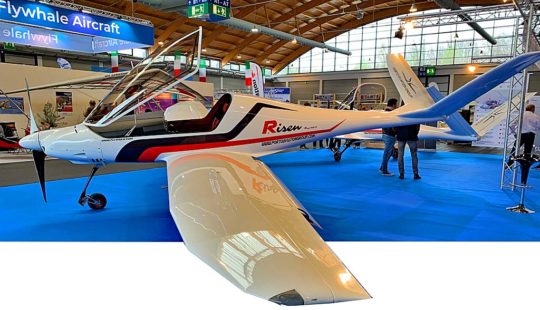
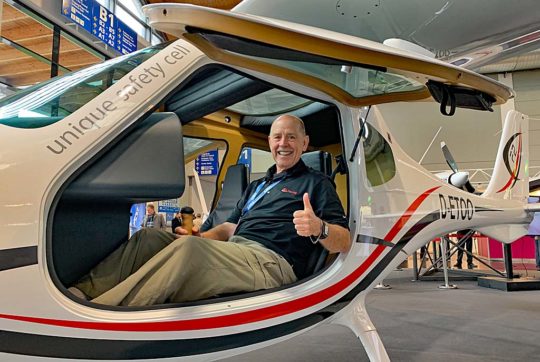
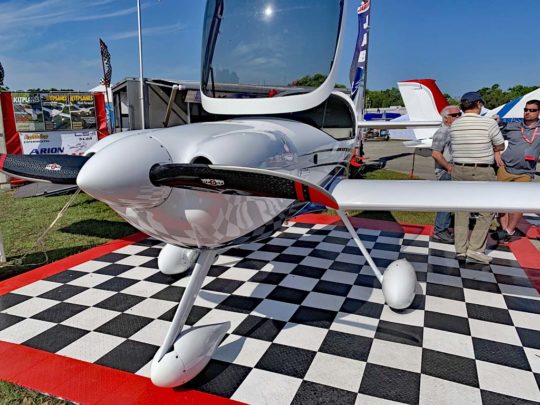
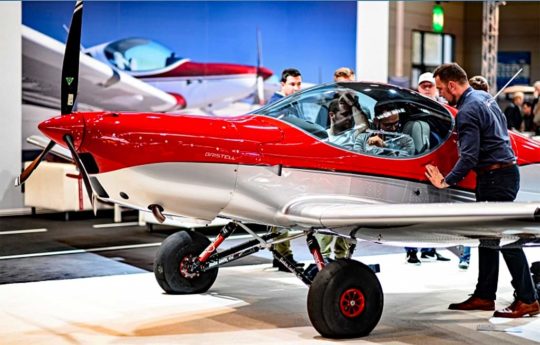
 "The best practices of scientific and health resources are being followed as we prepare for our 2020 event. At
"The best practices of scientific and health resources are being followed as we prepare for our 2020 event. At 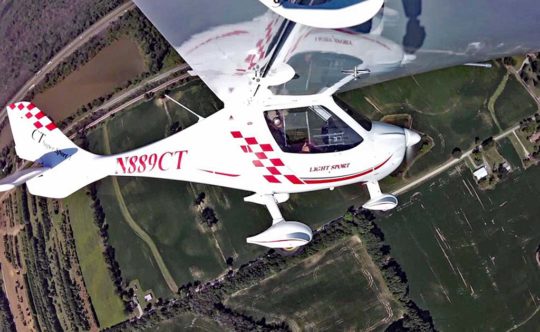 How does one LSA brand rise and stay above others?
How does one LSA brand rise and stay above others?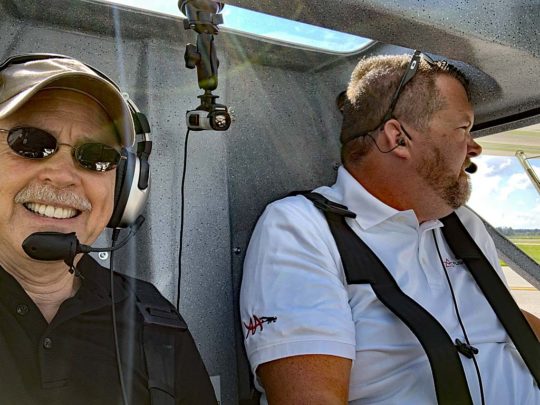 My tongue-in-cheek subtitle comes from the perspective of an average-sized pilot talking to the father and son team of Tom Sr. and Tom Jr. Gutmann. These gentle giants stand so tall above me that even Tom Cruise's acting box would not let me look this pair eye-to-eye.
Indeed, it is a tribute to the spaciousness of CT-series interiors that both these beefy fellows fit inside comfortably. Don't try that in a Cessna 150 (or even a 172)!
Flight Design's CT-series is roomy inside, 49 inches wide, a full 10 inches more than a Cessna 172. It also has super visibility. These facts are true of both CTLS, the current flagship of the German producer, and for the newest CT Super Sport, as seen in most of the nearby photos. The image of the two of us in the cockpit clearly shows that Tom Jr. and I have several inches between our shoulders and we were not smashed up against the door to produce this view.
My tongue-in-cheek subtitle comes from the perspective of an average-sized pilot talking to the father and son team of Tom Sr. and Tom Jr. Gutmann. These gentle giants stand so tall above me that even Tom Cruise's acting box would not let me look this pair eye-to-eye.
Indeed, it is a tribute to the spaciousness of CT-series interiors that both these beefy fellows fit inside comfortably. Don't try that in a Cessna 150 (or even a 172)!
Flight Design's CT-series is roomy inside, 49 inches wide, a full 10 inches more than a Cessna 172. It also has super visibility. These facts are true of both CTLS, the current flagship of the German producer, and for the newest CT Super Sport, as seen in most of the nearby photos. The image of the two of us in the cockpit clearly shows that Tom Jr. and I have several inches between our shoulders and we were not smashed up against the door to produce this view.
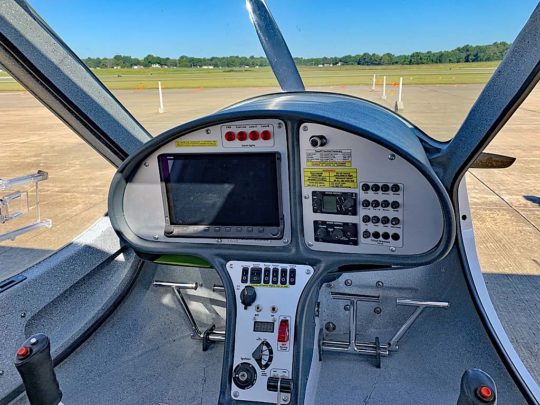 Tom and I flew Super Sport at the
Tom and I flew Super Sport at the 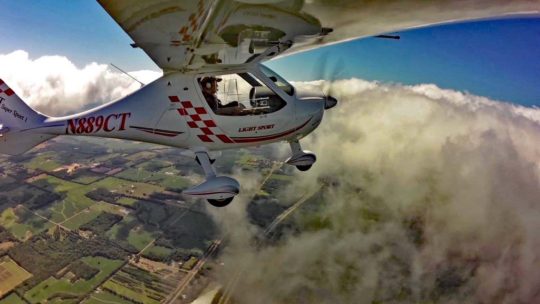 What you don't get with CT Super Sport is the back window and hat rack cabin space of CTLS. The slight enlargement of the longer, fancier LS does indeed make the cabin feel roomier and you have less space for things you need in the cockpit — though the floor compartments in front of both seats will suffice for most things you may want to access during flight. Both models keep the ample storage area aft of the cabin but you cannot access that while flying.
For this review, Super Sport was equipped with the
What you don't get with CT Super Sport is the back window and hat rack cabin space of CTLS. The slight enlargement of the longer, fancier LS does indeed make the cabin feel roomier and you have less space for things you need in the cockpit — though the floor compartments in front of both seats will suffice for most things you may want to access during flight. Both models keep the ample storage area aft of the cabin but you cannot access that while flying.
For this review, Super Sport was equipped with the 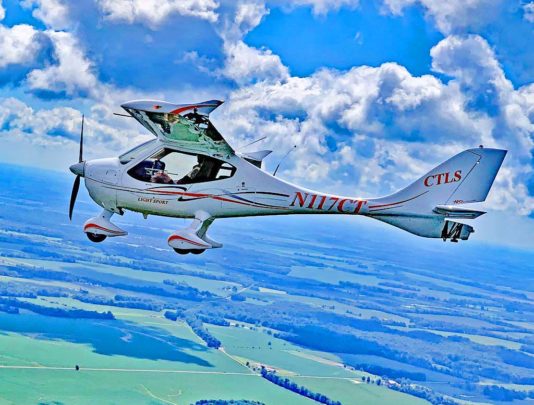 Coordinating closely with
Coordinating closely with 
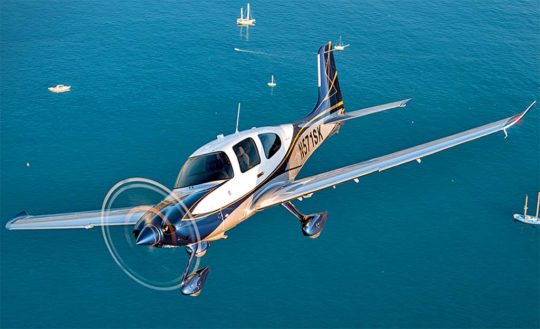 If you like airplane statistics and facts, this article may interest you. Some pilots don't follow such things while others eat it up (you know who you are). For these readers, we have a new perspective that many may find intriguing.
The comparisons below relate to the numbers of Single Engine Piston (SEP) general aviation (GA) aircraft on the U.S. registry compared to an umbrella group including SLSA, ELSA, and kit-built aircraft that Sport Pilots may fly (or those using a different certificate but exercising the privileges of Sport Pilot) …in other words, all the aircraft we cover on this website.
Even after more than 15 years of LSA and the kits that Sport Pilots can fly, the GA fleet still seems immeasurably larger. The truth is, we can measure it; in fact, we have up-to-date info and both are as accurate as FAA's database allows.
If you like airplane statistics and facts, this article may interest you. Some pilots don't follow such things while others eat it up (you know who you are). For these readers, we have a new perspective that many may find intriguing.
The comparisons below relate to the numbers of Single Engine Piston (SEP) general aviation (GA) aircraft on the U.S. registry compared to an umbrella group including SLSA, ELSA, and kit-built aircraft that Sport Pilots may fly (or those using a different certificate but exercising the privileges of Sport Pilot) …in other words, all the aircraft we cover on this website.
Even after more than 15 years of LSA and the kits that Sport Pilots can fly, the GA fleet still seems immeasurably larger. The truth is, we can measure it; in fact, we have up-to-date info and both are as accurate as FAA's database allows.
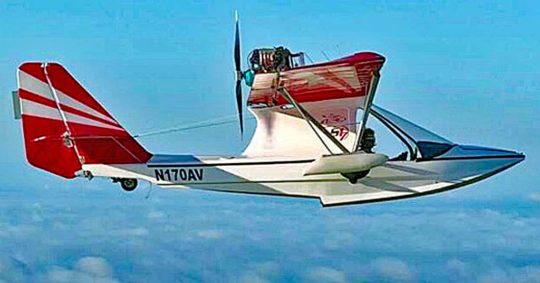
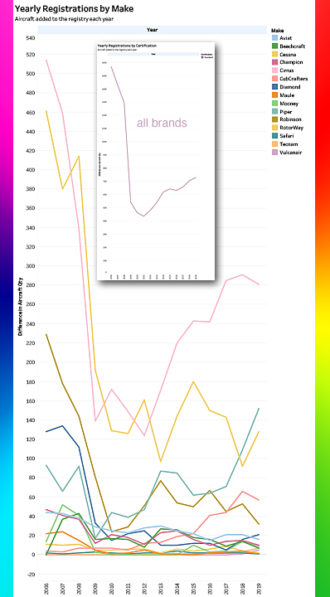 When you go global with these two aviation sectors, you find the USA has 80% of the GA fleet with the entire rest of the globe flying the other 20%.
The table is turned upside down for LSA/SP kits, where the USA has about 20% of the global total and all other countries account for 80%. However, the U.S. share appears to be increasing gradually since the recession of 2007-2009. As you can note that recession hit GA very hard; the GA industry has yet to recover to pre-recession registrations.
When you go global with these two aviation sectors, you find the USA has 80% of the GA fleet with the entire rest of the globe flying the other 20%.
The table is turned upside down for LSA/SP kits, where the USA has about 20% of the global total and all other countries account for 80%. However, the U.S. share appears to be increasing gradually since the recession of 2007-2009. As you can note that recession hit GA very hard; the GA industry has yet to recover to pre-recession registrations.
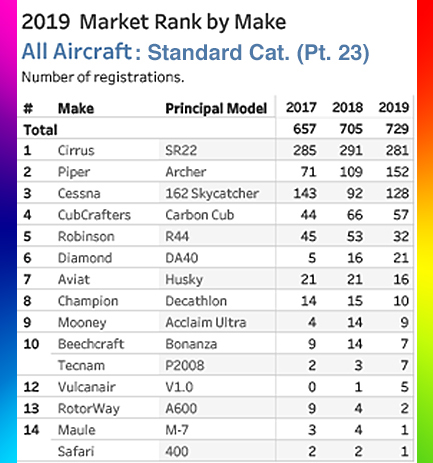 Take Cirrus out of the count and GA registered 448 aircraft from 15 producers, only 65% as many as all LSA/SP kit producers registered.
Although we have clear leaders in LSA/SP kits (see chart), the 690 aircraft come from an impressive list of 171 producers, more than 11 times more manufacturers than for SEP GA aircraft. This clearly illustrates what happens when you free up the design energy and productive spirit of small aviation companies.
Given a means of market entry, we saw the arrival of a new batch of manufacturers with a flock of new models to satisfy the diverse interests of pilots: from those seeking speedy cross country cruisers to back country taildraggers to special flying machines like gyroplanes, weight shift trikes, and powered parachutes.
Take Cirrus out of the count and GA registered 448 aircraft from 15 producers, only 65% as many as all LSA/SP kit producers registered.
Although we have clear leaders in LSA/SP kits (see chart), the 690 aircraft come from an impressive list of 171 producers, more than 11 times more manufacturers than for SEP GA aircraft. This clearly illustrates what happens when you free up the design energy and productive spirit of small aviation companies.
Given a means of market entry, we saw the arrival of a new batch of manufacturers with a flock of new models to satisfy the diverse interests of pilots: from those seeking speedy cross country cruisers to back country taildraggers to special flying machines like gyroplanes, weight shift trikes, and powered parachutes. 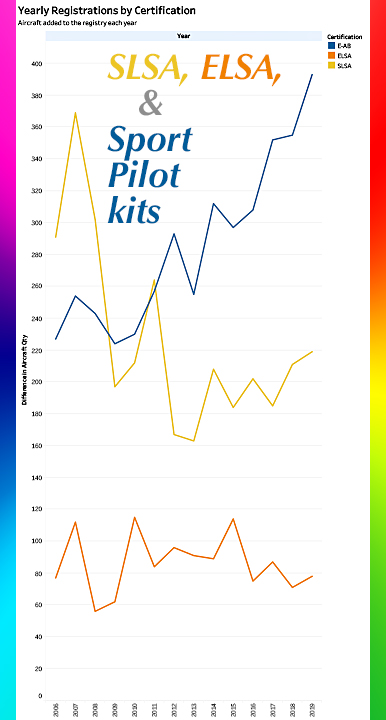
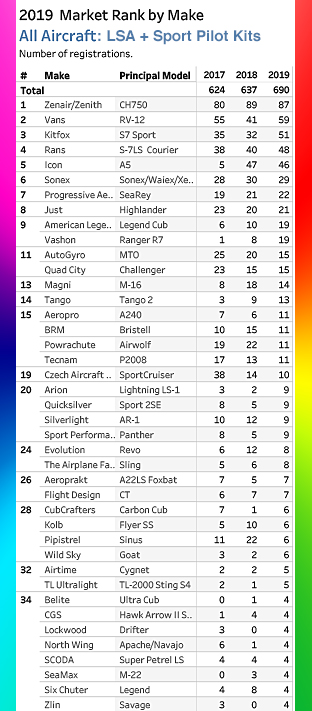

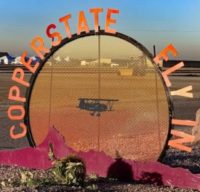
 FAA permits two place hang glider for instructional purposes, and believe me, every one going for a flight is going to learn plenty. Still, an instructor needs to know his or her student and preflight coaching is essential. To achieve a perfect safety record, Mike has clearly set some proper techniques to work for him.
Check this figure — Over his years in business, Mike reports taking more than 5,000 tandem flights from hills around San Francisco. For comparison, imagine giving 5,000 Young Eagle flights. In that context, 5,000 becomes a very big number. You can do your own math on how long it takes to achieve that.
FAA permits two place hang glider for instructional purposes, and believe me, every one going for a flight is going to learn plenty. Still, an instructor needs to know his or her student and preflight coaching is essential. To achieve a perfect safety record, Mike has clearly set some proper techniques to work for him.
Check this figure — Over his years in business, Mike reports taking more than 5,000 tandem flights from hills around San Francisco. For comparison, imagine giving 5,000 Young Eagle flights. In that context, 5,000 becomes a very big number. You can do your own math on how long it takes to achieve that.
 Each of Mike's tandem flights isn't walking out on the airport ramp and hopping in a plane for an hour. Coaching, driving up to the launch site, setting up the glider, launching into flight, and retrieving from landing consumes much more than an hour even if the flight itself may be short. Doing this thousands of times with excellent success speaks to using best practices.
So, Mike comes to flying
Each of Mike's tandem flights isn't walking out on the airport ramp and hopping in a plane for an hour. Coaching, driving up to the launch site, setting up the glider, launching into flight, and retrieving from landing consumes much more than an hour even if the flight itself may be short. Doing this thousands of times with excellent success speaks to using best practices.
So, Mike comes to flying 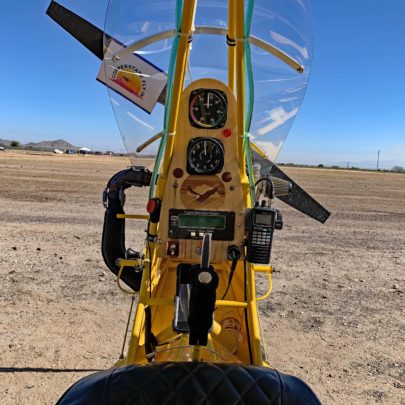 Look at that cockpit view (a different angle shows in the video). What more could you need?
Mike keeps his AirBike on the same airport as
Look at that cockpit view (a different angle shows in the video). What more could you need?
Mike keeps his AirBike on the same airport as 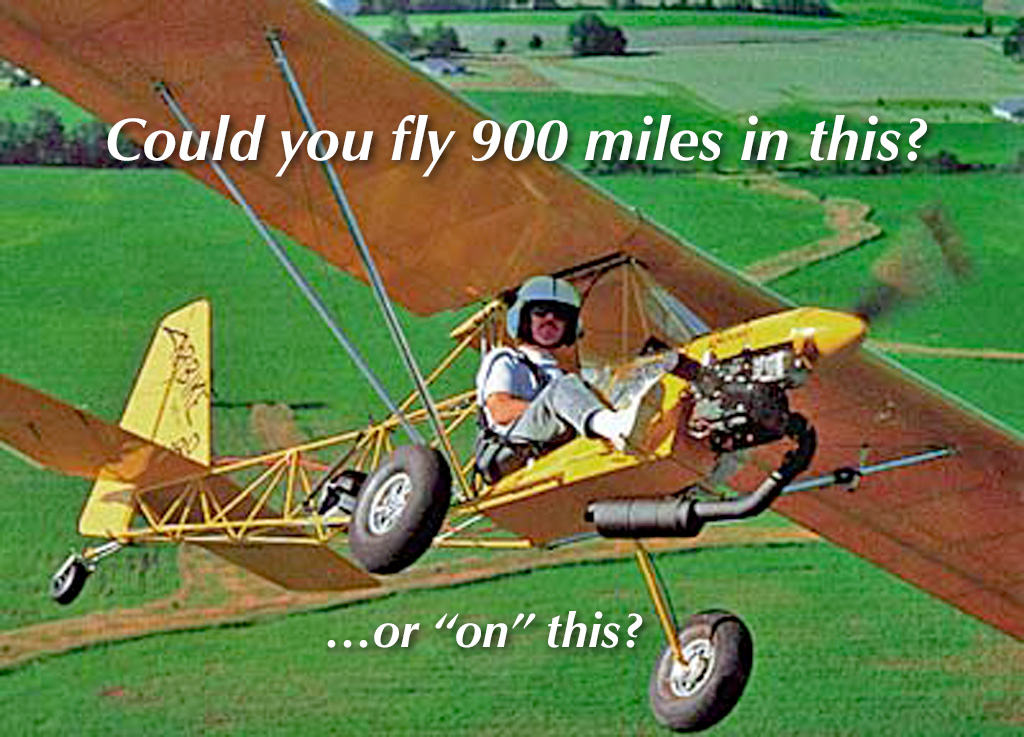
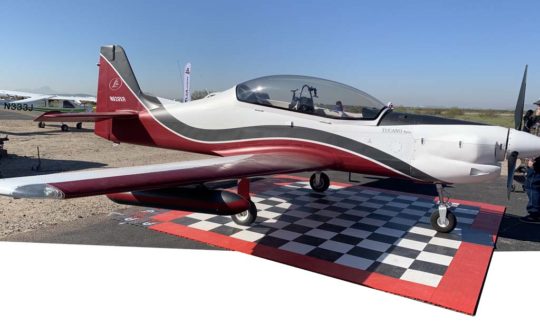 Just one year ago, I flew Tucano for the first time. The small-scale fighter-like aircraft was dashing with its modified Rotax 912 producing 140 horsepower.
This year, that experience was updated with the Tucano 915iS. The newest from Austrian aircraft engine leader, Rotax, adds only one additional horsepower but with its turbocharger and intercooler, the comparison was striking.
Just one year ago, I flew Tucano for the first time. The small-scale fighter-like aircraft was dashing with its modified Rotax 912 producing 140 horsepower.
This year, that experience was updated with the Tucano 915iS. The newest from Austrian aircraft engine leader, Rotax, adds only one additional horsepower but with its turbocharger and intercooler, the comparison was striking.
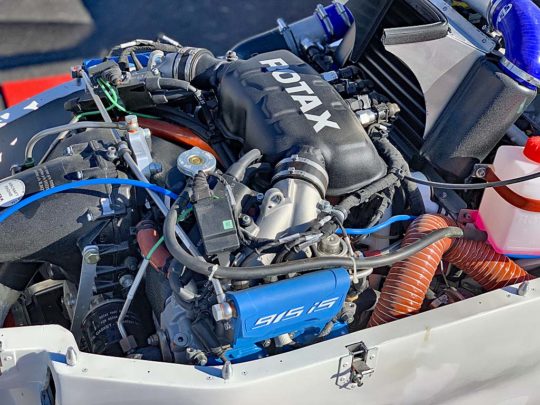 In a phrase: Tucano 915 climbs enthusiastically from take off to 10,000 feet without a decaying rate of climb.
As you can see in the image below, Tucano 915 easily maintained well over 1,000 fpm; we went to about 9,500 feet. All the way, 915 appeared to easily compensate for the change in altitude that my ears confirmed was happening.
Before I can write about cruise speed or fuel economy with Tucano 915, I want to again remark that Tucano conveys a visceral appeal. It feels like you think a fighter cockpit should feel. The two I've flown were finished with military gray inside and you sit lower in the cockpit, covered by a huge, very sturdy canopy that affords a very wide field of view.
In a phrase: Tucano 915 climbs enthusiastically from take off to 10,000 feet without a decaying rate of climb.
As you can see in the image below, Tucano 915 easily maintained well over 1,000 fpm; we went to about 9,500 feet. All the way, 915 appeared to easily compensate for the change in altitude that my ears confirmed was happening.
Before I can write about cruise speed or fuel economy with Tucano 915, I want to again remark that Tucano conveys a visceral appeal. It feels like you think a fighter cockpit should feel. The two I've flown were finished with military gray inside and you sit lower in the cockpit, covered by a huge, very sturdy canopy that affords a very wide field of view.
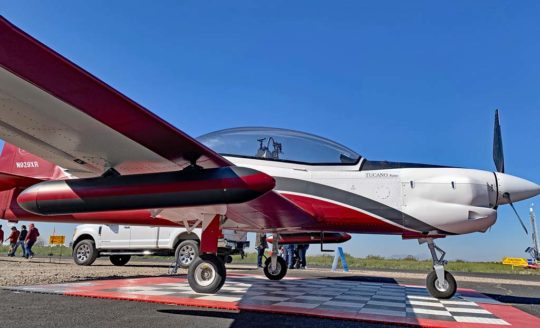
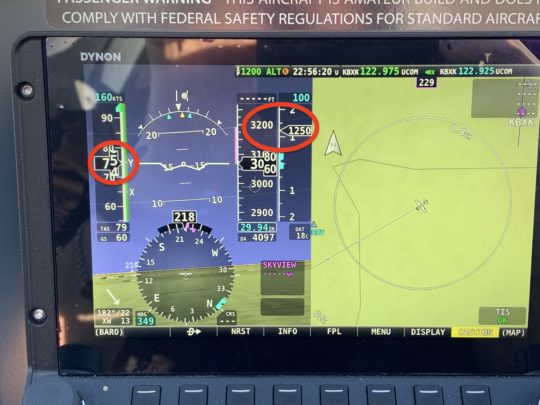
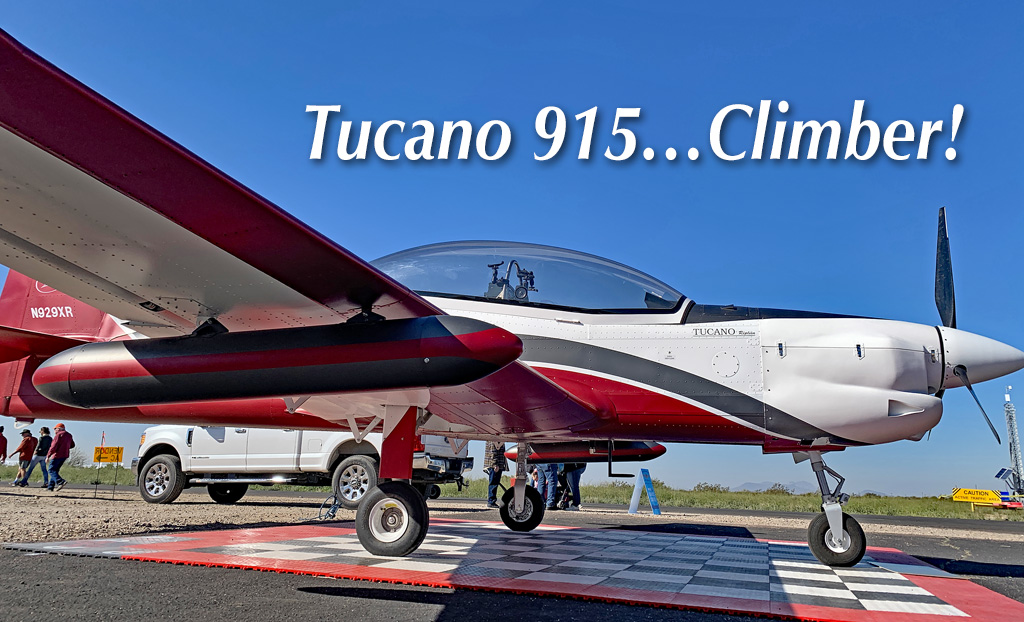
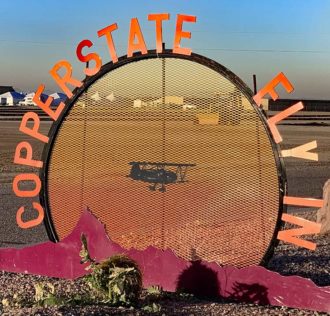 One of the reasons why Videoman Dave and I attend smaller events is because we can do a particular kind of work while visiting: Video Pilot Reports. We've now done many dozens of these (among some 700 total videos on Light-Sport Aircraft, Sport Pilot kit aircraft, and ultralights).
Interviewing developers, pilots, and enthusiasts about all sorts of airplanes is our stock-in-trade. People approach us at shows all the time expressing how much they enjoy these YouTube videos.
These range 7-15 minutes long, take an hour or so to shoot and a day or two (sometimes more) to edit and publish on
One of the reasons why Videoman Dave and I attend smaller events is because we can do a particular kind of work while visiting: Video Pilot Reports. We've now done many dozens of these (among some 700 total videos on Light-Sport Aircraft, Sport Pilot kit aircraft, and ultralights).
Interviewing developers, pilots, and enthusiasts about all sorts of airplanes is our stock-in-trade. People approach us at shows all the time expressing how much they enjoy these YouTube videos.
These range 7-15 minutes long, take an hour or so to shoot and a day or two (sometimes more) to edit and publish on 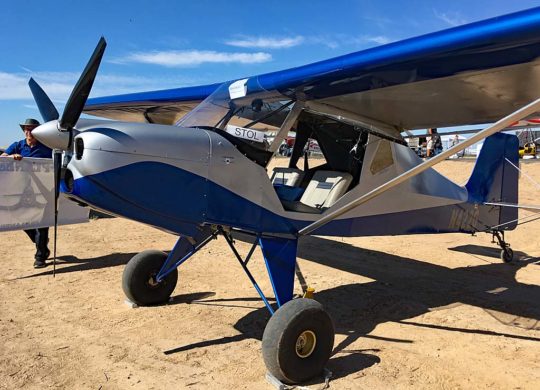 Strapping six or seven cameras all over the airplane, discussing what we want to accomplish aloft, video recording takeoffs and landing, sometimes shooting video and stills from a second airplane, and then doing what we call a "stand up" near the airplane where we review the flight qualities discovered during an hour or so of flying. VPRs are a fun and a learning experience. Viewers appear to love them. Yet they drink up lots of time and trying to do these at a jam-packed major show is difficult or impossible. Hence, our love of events like
Strapping six or seven cameras all over the airplane, discussing what we want to accomplish aloft, video recording takeoffs and landing, sometimes shooting video and stills from a second airplane, and then doing what we call a "stand up" near the airplane where we review the flight qualities discovered during an hour or so of flying. VPRs are a fun and a learning experience. Viewers appear to love them. Yet they drink up lots of time and trying to do these at a jam-packed major show is difficult or impossible. Hence, our love of events like 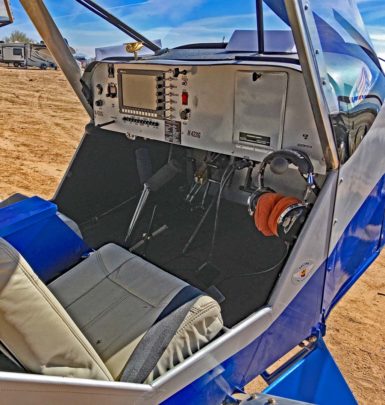 After discovering the model a year ago, we did a interview with Garret Komm at last year's Copperstate. We followed up with more at EAA AirVenture Oshklosh last year as well. The two interviews have been seen some 70,000 times (both videos) and have introduced his Mule experimental amateur built kit to the many who enjoyed watching.
At
After discovering the model a year ago, we did a interview with Garret Komm at last year's Copperstate. We followed up with more at EAA AirVenture Oshklosh last year as well. The two interviews have been seen some 70,000 times (both videos) and have introduced his Mule experimental amateur built kit to the many who enjoyed watching.
At 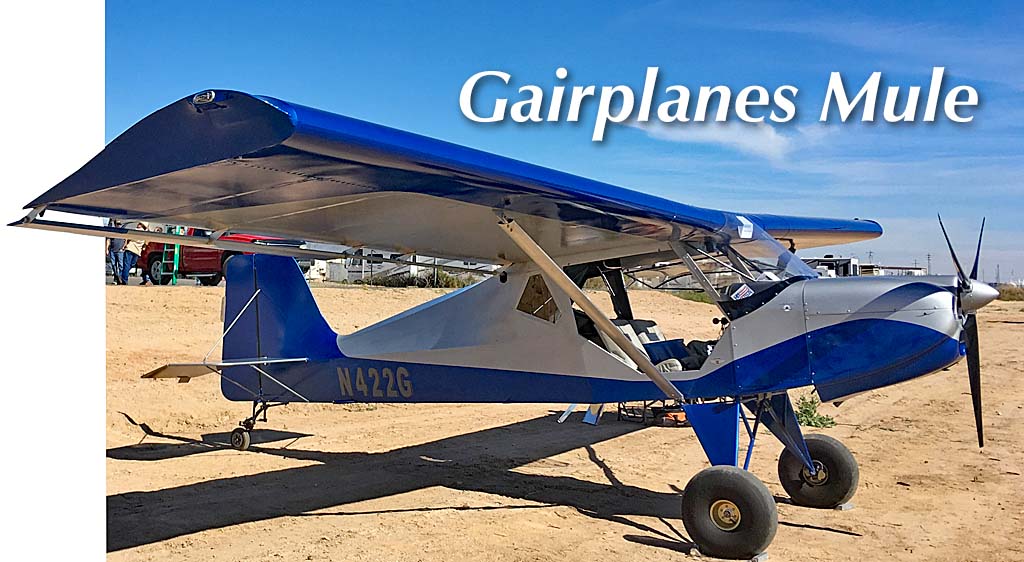
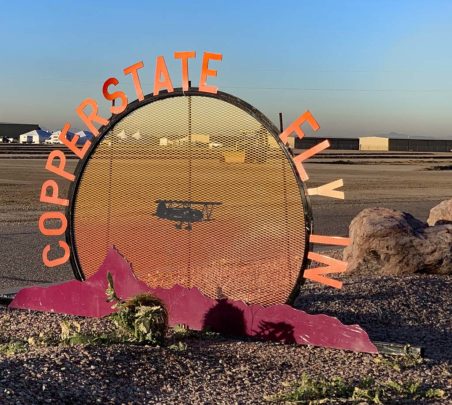
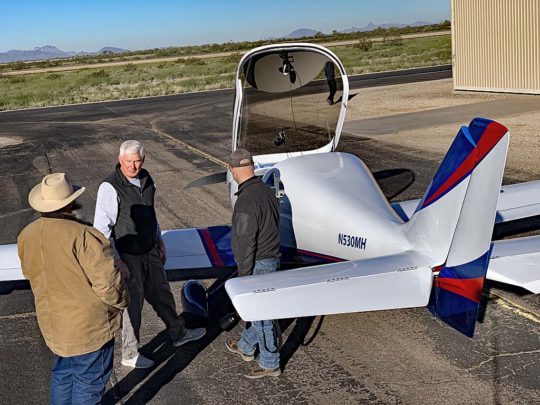 To start this year's event,
To start this year's event, 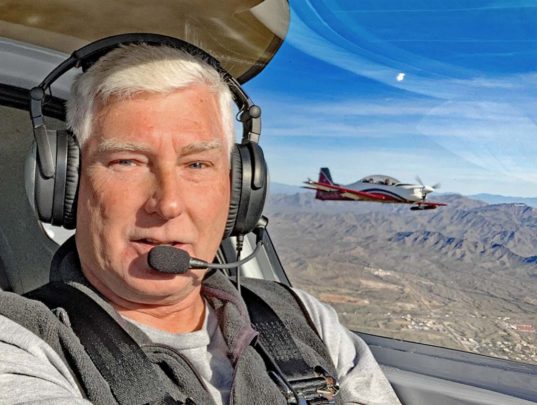
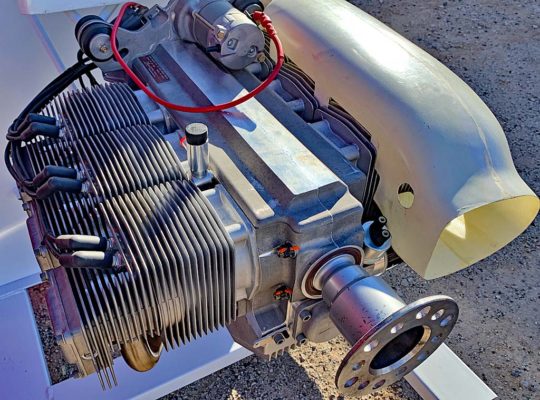
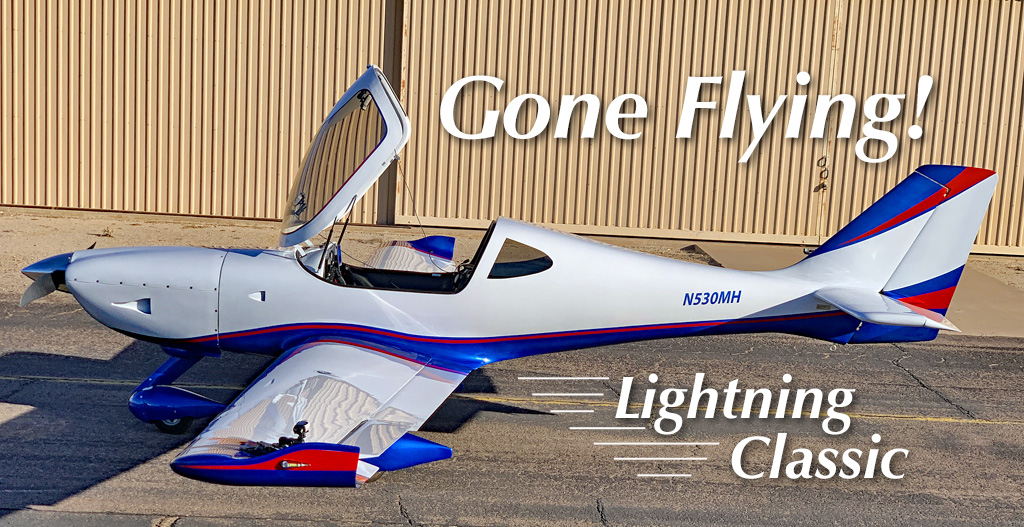
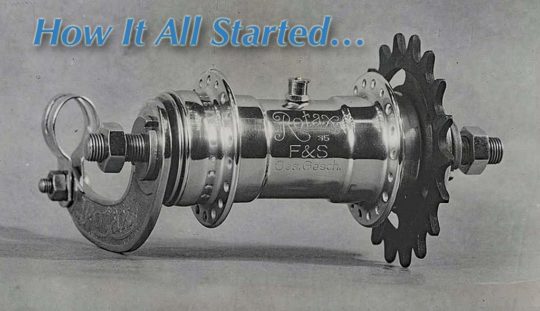 It started with a seemingly simple product. Since long before recreational aircraft arrived, the invention that launched the Rotax brand was a "rotary axle," a freewheeling hub that advanced the then-state-of-the-art in bicycles.
Get it? ROTary AXle. This goes way back; a patent was issued in 1906 to entrepreneur designer, Friedrich Gottschalk, only three years after Orville and Wilbur Wright (also bicycle guys) made their first flight.
Gottschalk owned a successful bicycle components factory in Dresden, Germany at the turn of the previous century. A cyclist himself, he became a full-support producer, making everything needed for bicycles: brakes, tires, seats, and more. "Anyone who considered themselves as a cyclist wanted a bicycle with a Rotax freewheel hub," said the Austrian company.
It started with a seemingly simple product. Since long before recreational aircraft arrived, the invention that launched the Rotax brand was a "rotary axle," a freewheeling hub that advanced the then-state-of-the-art in bicycles.
Get it? ROTary AXle. This goes way back; a patent was issued in 1906 to entrepreneur designer, Friedrich Gottschalk, only three years after Orville and Wilbur Wright (also bicycle guys) made their first flight.
Gottschalk owned a successful bicycle components factory in Dresden, Germany at the turn of the previous century. A cyclist himself, he became a full-support producer, making everything needed for bicycles: brakes, tires, seats, and more. "Anyone who considered themselves as a cyclist wanted a bicycle with a Rotax freewheel hub," said the Austrian company.
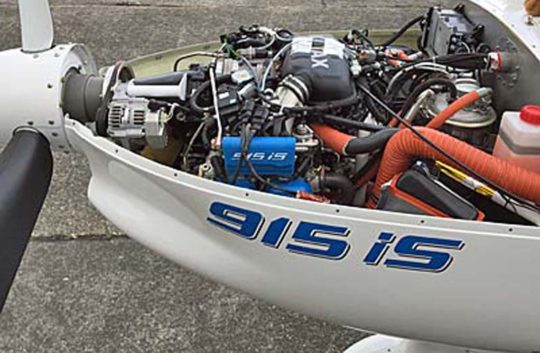
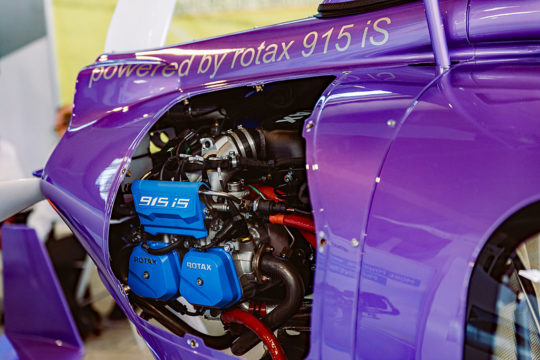 "
"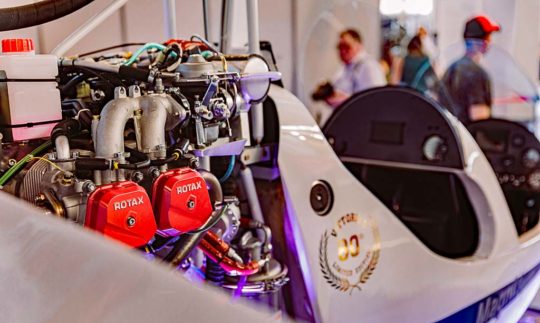 To aviators, the company's compact and light weight engines are seen on many kinds of aircraft, supplied by more than 250 OEMs (Original Equipment Manufacturers).
"Our goal is always to maximize the fun and to minimize the weight," said Rotax. "Our experienced engineering team and a wide spectrum of R&D facilities guarantee Rotax can deliver customer-oriented solutions and exceed customer expectations."
To aviators, the company's compact and light weight engines are seen on many kinds of aircraft, supplied by more than 250 OEMs (Original Equipment Manufacturers).
"Our goal is always to maximize the fun and to minimize the weight," said Rotax. "Our experienced engineering team and a wide spectrum of R&D facilities guarantee Rotax can deliver customer-oriented solutions and exceed customer expectations."
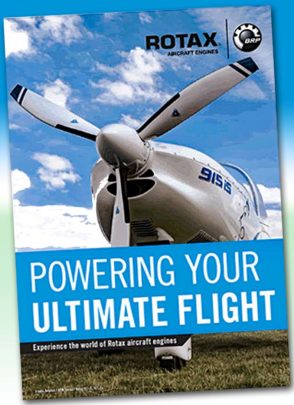 All Rotax aircraft engines "are approved for operation with Ethanol 10, automobile gasoline, and aviation-grade fuels." In many countries where avgas is hard to find or unavailable, premium auto gas can be used — in fact, expert repair stations often report engines run on auto gas look even cleaner when brought in for inspection or maintenance.
"Low running costs and a design that pioneers power-to-weight ratio is why a majority of aircraft manufacturers worldwide place their trust in our technology," boasted Rotax. Distribution and service of the tens of thousands of Rotax aircraft engines and parts is performed by 200 authorized distributors, service centers and repair centers all over the world.
"As the largest producer of small gasoline aircraft engines in the world, our aircraft engines are the first choice of more than 250 aircraft manufacturers around the globe."
All Rotax aircraft engines "are approved for operation with Ethanol 10, automobile gasoline, and aviation-grade fuels." In many countries where avgas is hard to find or unavailable, premium auto gas can be used — in fact, expert repair stations often report engines run on auto gas look even cleaner when brought in for inspection or maintenance.
"Low running costs and a design that pioneers power-to-weight ratio is why a majority of aircraft manufacturers worldwide place their trust in our technology," boasted Rotax. Distribution and service of the tens of thousands of Rotax aircraft engines and parts is performed by 200 authorized distributors, service centers and repair centers all over the world.
"As the largest producer of small gasoline aircraft engines in the world, our aircraft engines are the first choice of more than 250 aircraft manufacturers around the globe."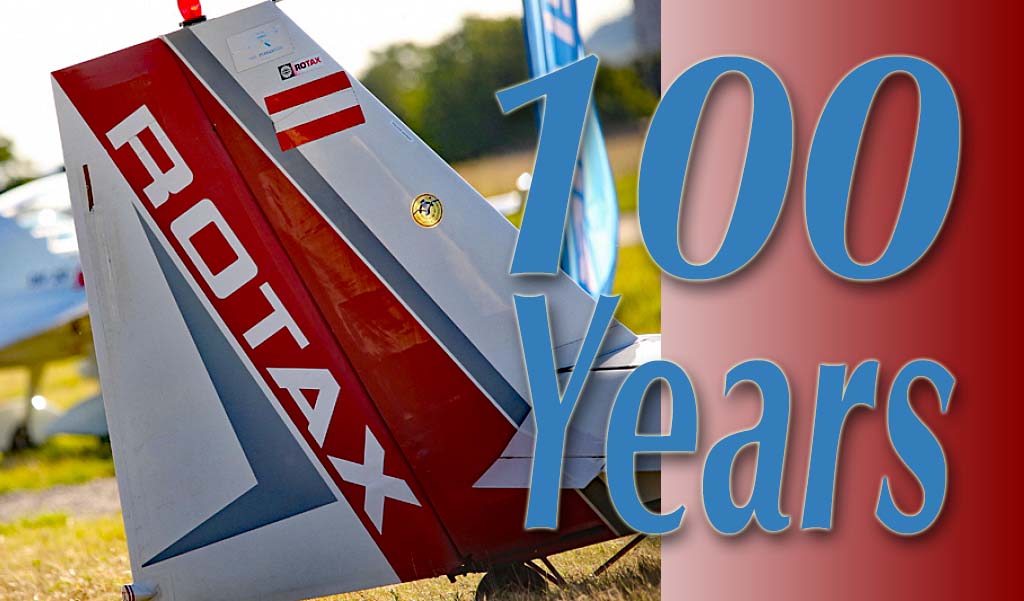
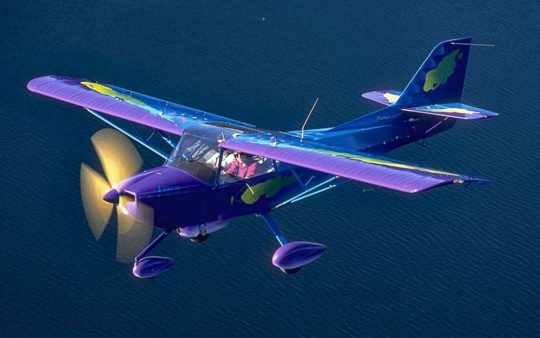 A huge thanks to our supreme "datastician," Steve Beste for making such swift and accurate reporting possible. I assure you that I've looked high and low for every year LSA have existed to find no comparable information.
As always, be advised that our data comes from FAA's aircraft registration database. That means it is impartial — hopefully meaning reliable and dependable — but it also means some massaging of the information is needed to be completely accurate. (
A huge thanks to our supreme "datastician," Steve Beste for making such swift and accurate reporting possible. I assure you that I've looked high and low for every year LSA have existed to find no comparable information.
As always, be advised that our data comes from FAA's aircraft registration database. That means it is impartial — hopefully meaning reliable and dependable — but it also means some massaging of the information is needed to be completely accurate. (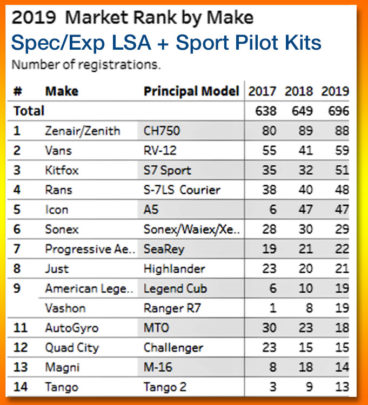 Overview
Overview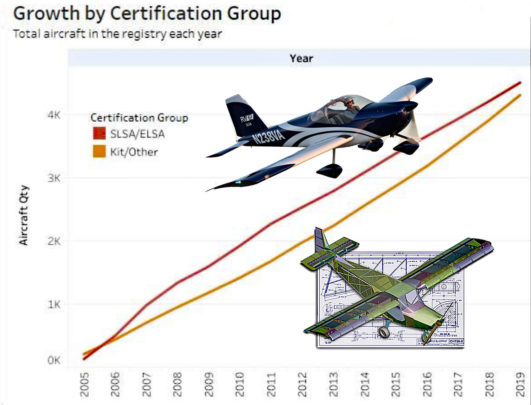 However, as he added, "All did not have the same experience. Kitfox registrations increased by 60% (as the Idaho company appeared to lose some momentum in 2018). Van's Aircraft grew by 44% and Rans by 20% but Zenair/Zenith and Sonex were modestly off their previous pace (see chart below)."
For reference, here is our 3Q19 market share report with additional details you might find interesting.
However, as he added, "All did not have the same experience. Kitfox registrations increased by 60% (as the Idaho company appeared to lose some momentum in 2018). Van's Aircraft grew by 44% and Rans by 20% but Zenair/Zenith and Sonex were modestly off their previous pace (see chart below)."
For reference, here is our 3Q19 market share report with additional details you might find interesting.
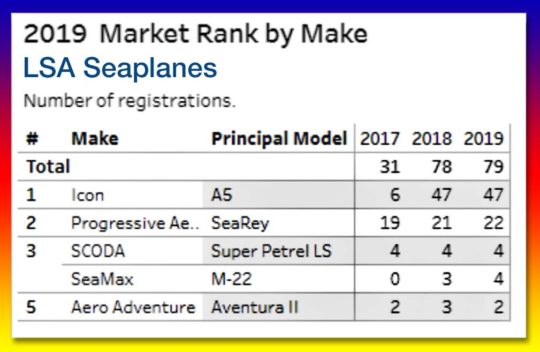 Steve wrote, "Regarding Icon's numbers, note that historical figures often differ from what was previously reported," in this case with Icon and its A5. He continued, "This happens because FAA continues to perfect its data. For example, for 2018 the agency reported 57 Icon A5s as '2018' aircraft but FAA data clerks switched 11 of those to '2019' once their late-in-the-year paperwork was done. Thus, we now report fewer than 57 Icons for 2018."
Despite these necessary adjustments, we maintain the figures used in this report are the best available and are of very high reliability. In fact, the adjustments Steve and I make are proof of the effort to report accurate, dependable data.
As always, I offer a loud and heartfelt THANKS! to Steve Beste for his work to make this information available.
Steve wrote, "Regarding Icon's numbers, note that historical figures often differ from what was previously reported," in this case with Icon and its A5. He continued, "This happens because FAA continues to perfect its data. For example, for 2018 the agency reported 57 Icon A5s as '2018' aircraft but FAA data clerks switched 11 of those to '2019' once their late-in-the-year paperwork was done. Thus, we now report fewer than 57 Icons for 2018."
Despite these necessary adjustments, we maintain the figures used in this report are the best available and are of very high reliability. In fact, the adjustments Steve and I make are proof of the effort to report accurate, dependable data.
As always, I offer a loud and heartfelt THANKS! to Steve Beste for his work to make this information available.
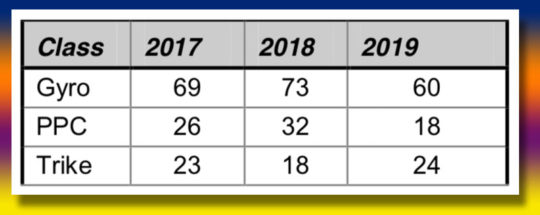 In general terms, Steve noted, "Alternate aircraft offer a mixed picture."
He reported, "We have no change from our third quarter 2019 report: Gyroplanes registrations are slowing slightly but are still hot. Trike registrations are holding steady. Powered parachutes registrations are off a bit (nearby chart).
In general terms, Steve noted, "Alternate aircraft offer a mixed picture."
He reported, "We have no change from our third quarter 2019 report: Gyroplanes registrations are slowing slightly but are still hot. Trike registrations are holding steady. Powered parachutes registrations are off a bit (nearby chart).
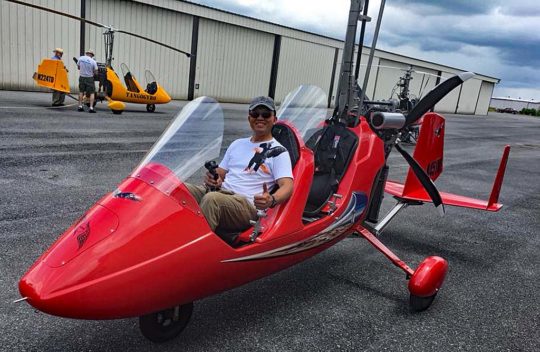 Gyroplanes
Gyroplanes Weight Shift Trikes
Weight Shift Trikes About this Report — “SP Kits” means Sport Pilot kit aircraft referring to amateur-built aircraft that can be flown by a pilot possessing a Sport Pilot certificate, or a pilot holding a Private Pilot certificate or higher who is exercising the privileges of Sport Pilot — meaning no aviation medical is required. Since Sport Pilot, as a form of pilot license, only arrived in late 2004, we collect information from FAA's Aircraft Registration database for all applicable kit-built aircraft that can be flown by a Sport Pilot plus, of course, all Special or Experimental LSA. Although some of the same kit aircraft existed before January 1, 2005, we omit them as it cannot be said those older aircraft could be flown by someone with a Sport Pilot certificate. This also evenly and fairly compares SP Kits with SLSA and ELSA.
** When using our online market share reporting system called
About this Report — “SP Kits” means Sport Pilot kit aircraft referring to amateur-built aircraft that can be flown by a pilot possessing a Sport Pilot certificate, or a pilot holding a Private Pilot certificate or higher who is exercising the privileges of Sport Pilot — meaning no aviation medical is required. Since Sport Pilot, as a form of pilot license, only arrived in late 2004, we collect information from FAA's Aircraft Registration database for all applicable kit-built aircraft that can be flown by a Sport Pilot plus, of course, all Special or Experimental LSA. Although some of the same kit aircraft existed before January 1, 2005, we omit them as it cannot be said those older aircraft could be flown by someone with a Sport Pilot certificate. This also evenly and fairly compares SP Kits with SLSA and ELSA.
** When using our online market share reporting system called 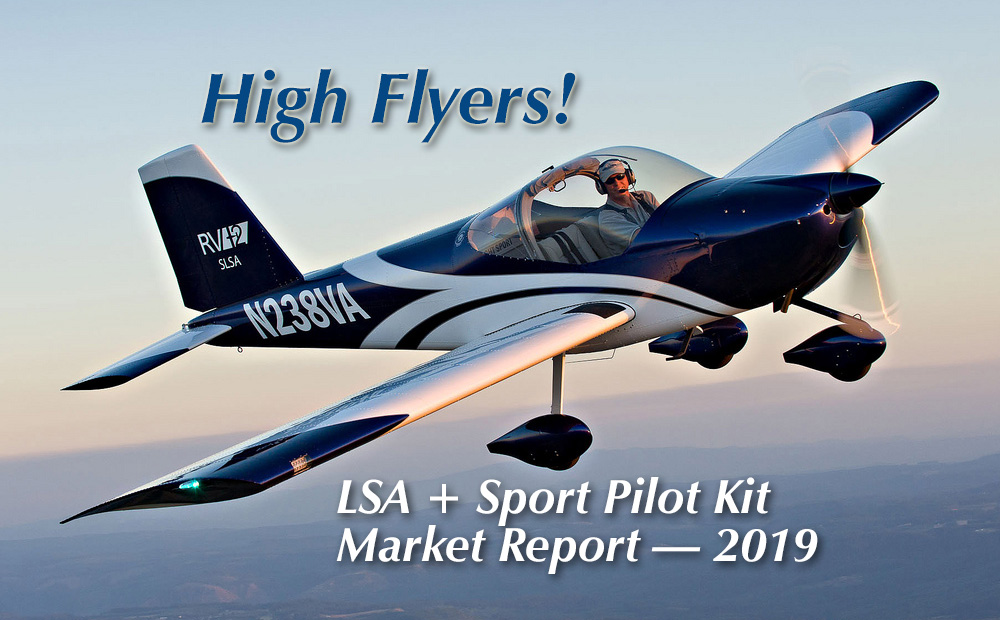
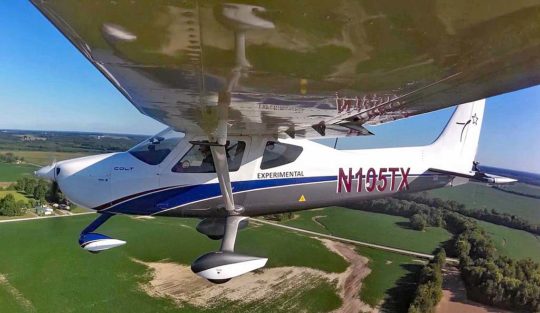 How about this for a great way to start off the new year — a brand-new airplane? Both pilot and manufacturer are smiling and with good reason: both are winners in this transaction, as it should be.
How about this for a great way to start off the new year — a brand-new airplane? Both pilot and manufacturer are smiling and with good reason: both are winners in this transaction, as it should be.
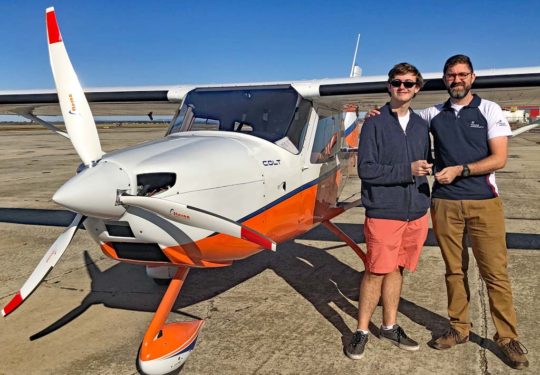
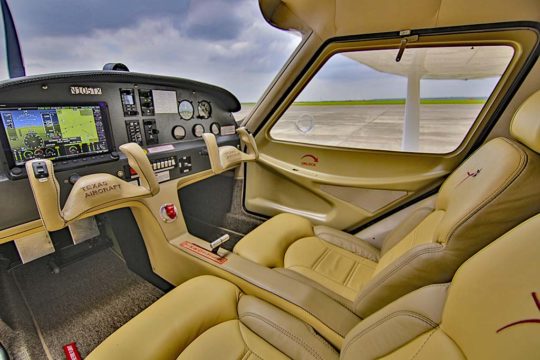 “
“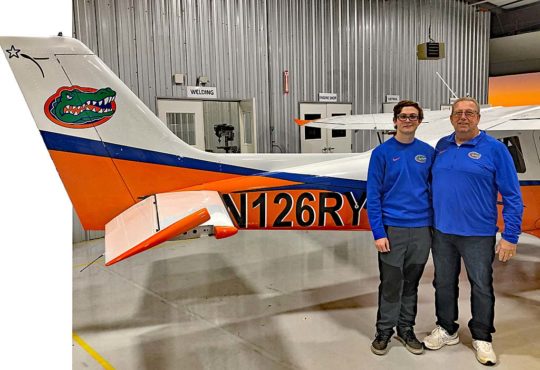
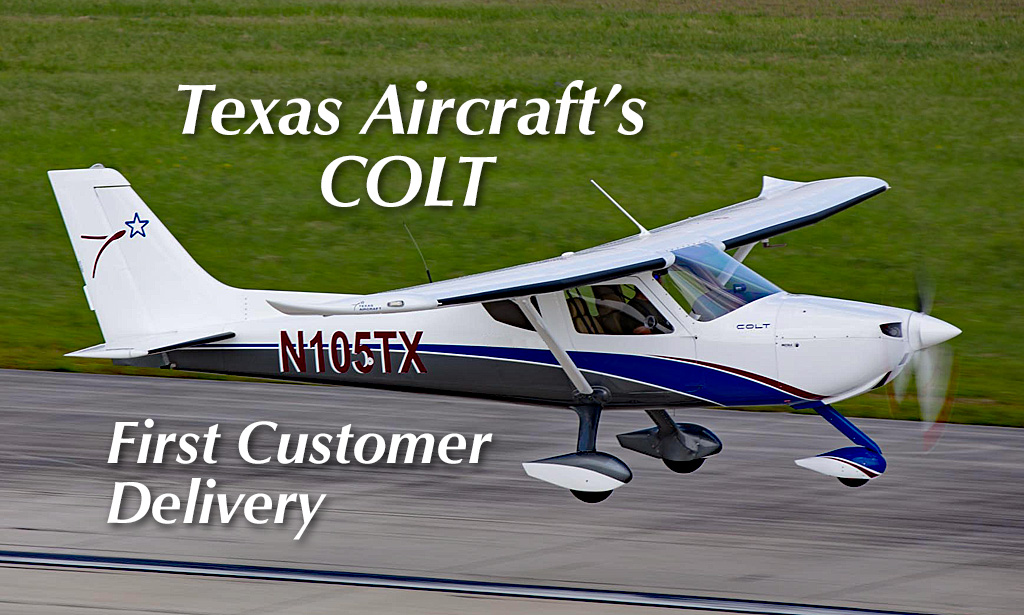
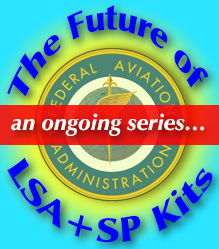 As we kick off a new year and a new decade, it feels like the starter's timer has just been clicked into action. The next four years should prove to be highly interesting — and for all of aviation, not only Light-Sport Aircraft, Sport Pilot kit aircraft, and ultralights. Change can be difficult, but it's coming. For the most part, I feel this is heading in a great direction even if some may struggle with elements of the new rule.
Earlier, an
As we kick off a new year and a new decade, it feels like the starter's timer has just been clicked into action. The next four years should prove to be highly interesting — and for all of aviation, not only Light-Sport Aircraft, Sport Pilot kit aircraft, and ultralights. Change can be difficult, but it's coming. For the most part, I feel this is heading in a great direction even if some may struggle with elements of the new rule.
Earlier, an 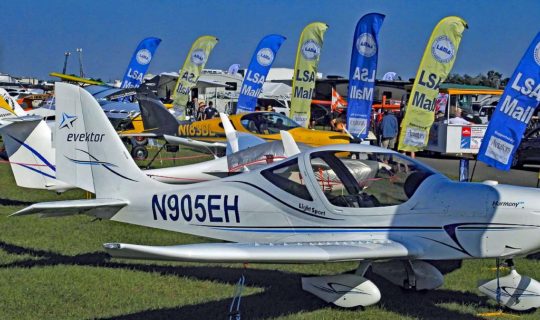 In this article, I will answer some common questions. The goal is not to repeat the earlier info but to provide clarification. Call this an FAQ (Frequently Asked Questions) review.
Light-Sport Aircraft are being presented with new opportunities and I hope both manufacturers and pilots will take full advantage of all the new rule may offer.
In this article, I will answer some common questions. The goal is not to repeat the earlier info but to provide clarification. Call this an FAQ (Frequently Asked Questions) review.
Light-Sport Aircraft are being presented with new opportunities and I hope both manufacturers and pilots will take full advantage of all the new rule may offer.

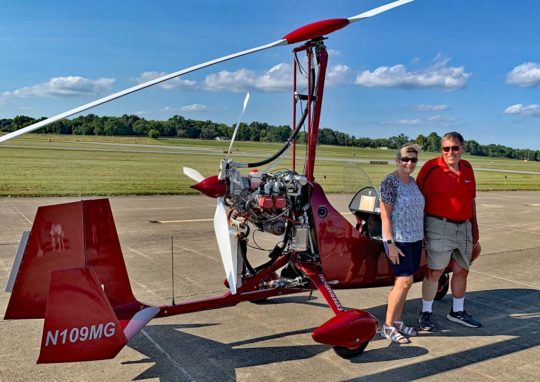
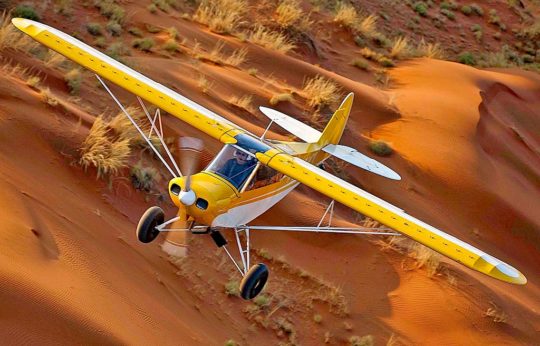 Higher speeds
Higher speeds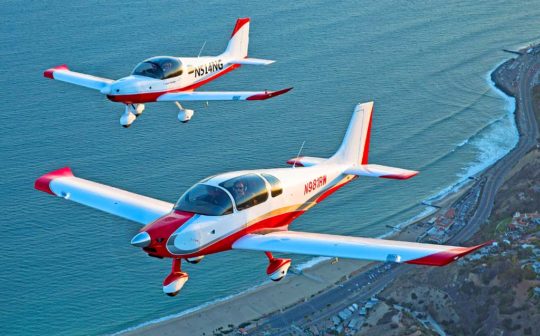

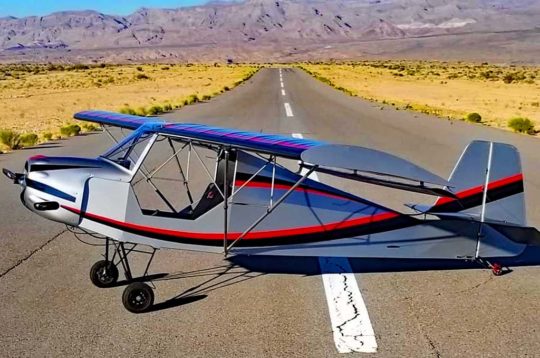
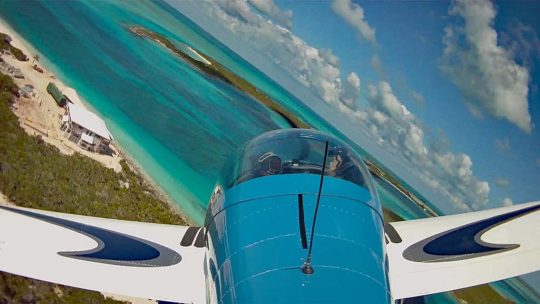 Perhaps more to the point, will FAA allow you to fly a 2,500-pound GA airplane with a Sport Pilot certificate …without getting a Class 1-2-3 medical? Alternatively, can a Sport Pilot fly a 3,000-pound new LSA? We don't know this either.
Our hope is that FAA will allow the Sport Pilot certificate to be used to fly heavier, more capable aircraft perhaps using the logbook endorsement method employed today. For example, a basic SP certificate does not allow flight into Class B airspace until the pilot has received additional training for this. However, after getting more instruction, a SP ticket holder can fly into Class B once securing only a logbook endorsement (no further testing is needed).
Perhaps more to the point, will FAA allow you to fly a 2,500-pound GA airplane with a Sport Pilot certificate …without getting a Class 1-2-3 medical? Alternatively, can a Sport Pilot fly a 3,000-pound new LSA? We don't know this either.
Our hope is that FAA will allow the Sport Pilot certificate to be used to fly heavier, more capable aircraft perhaps using the logbook endorsement method employed today. For example, a basic SP certificate does not allow flight into Class B airspace until the pilot has received additional training for this. However, after getting more instruction, a SP ticket holder can fly into Class B once securing only a logbook endorsement (no further testing is needed).
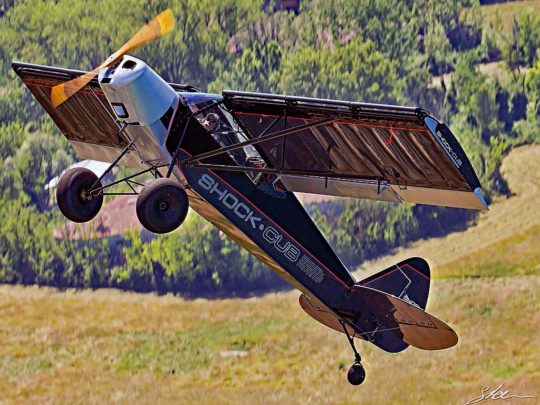
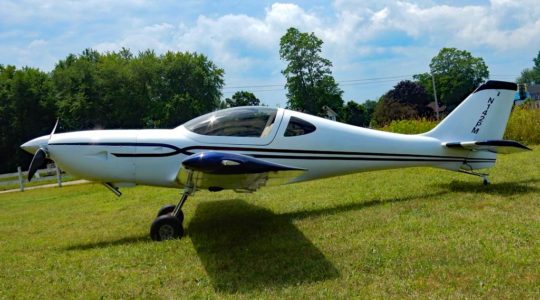

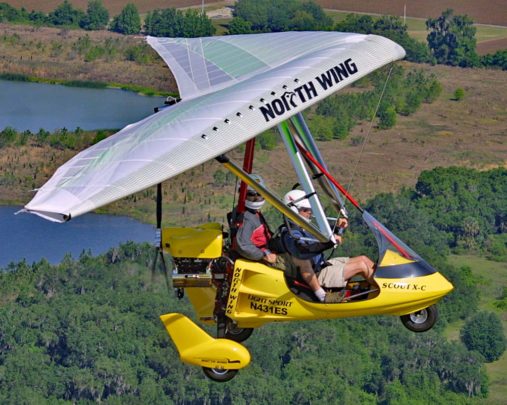
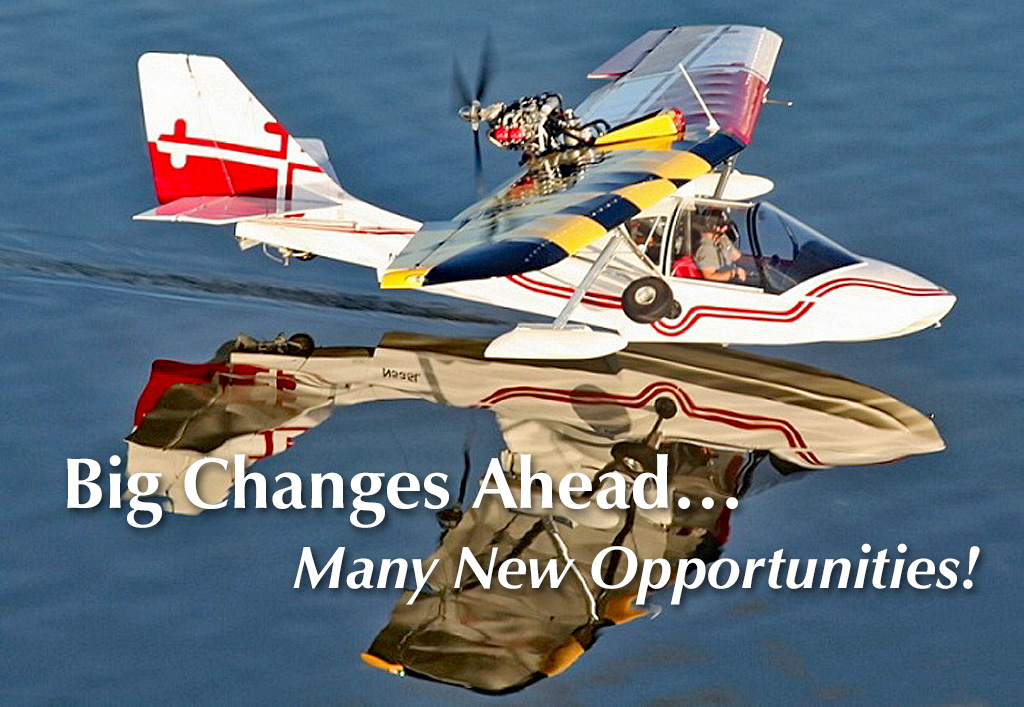
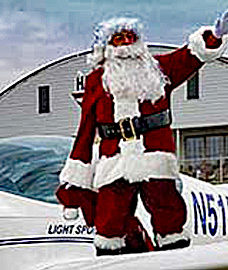 The last airshow (
The last airshow (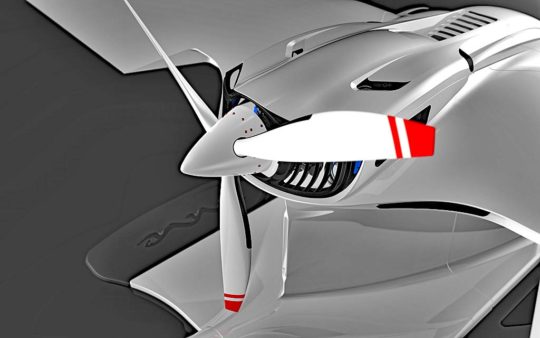 One of the most anticipated of these new Light-Sport Aircraft seaplanes is the
One of the most anticipated of these new Light-Sport Aircraft seaplanes is the 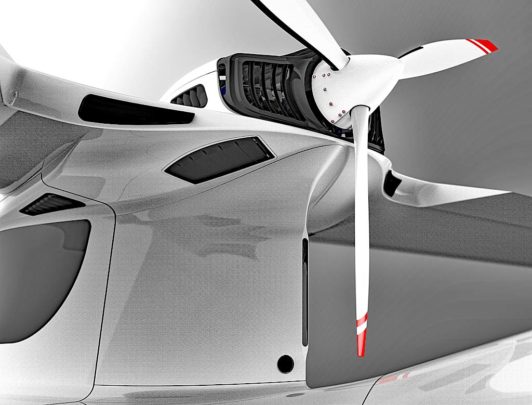 "As 2019 draws to a close, we are pleased to announce a new strategic partnership with
"As 2019 draws to a close, we are pleased to announce a new strategic partnership with 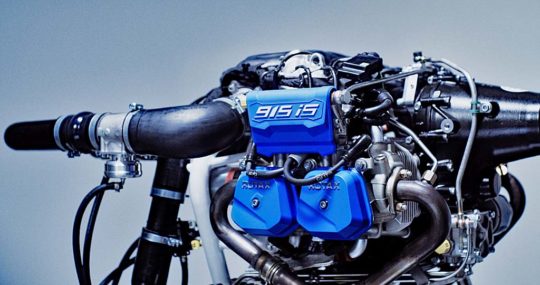 Earlier, as Vickers' team anticipated a higher weight — as did
Earlier, as Vickers' team anticipated a higher weight — as did 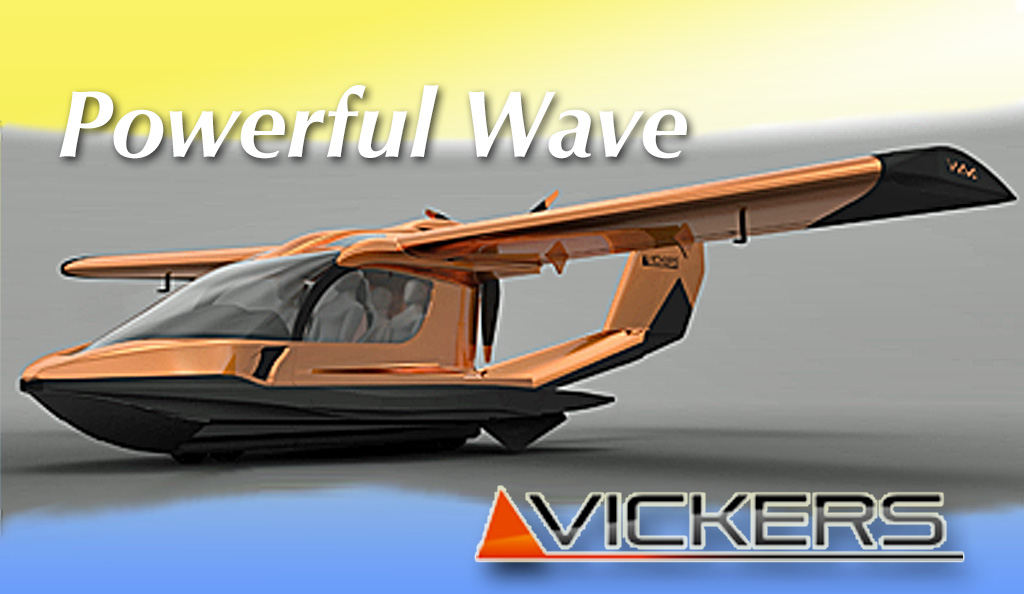
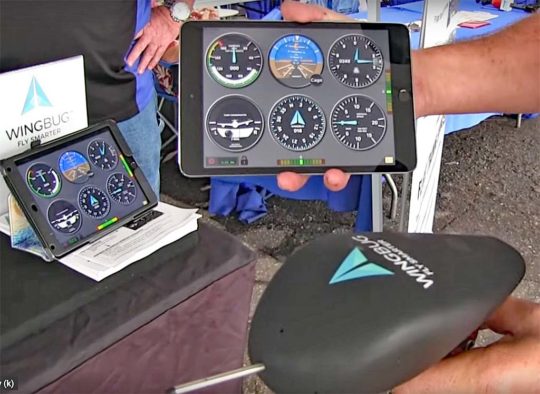 We begin a new year shortly and will keep our focus on the many enjoyable light airplanes. This industry and the pilots it serves have an exciting four years ahead as
We begin a new year shortly and will keep our focus on the many enjoyable light airplanes. This industry and the pilots it serves have an exciting four years ahead as  How about
How about  Until that rule arrives — probably in late 2023 — "Whisper can be a nice step up in airspeed and weight limits within the Experimental Amateur Built class." Deon's now-Florida-based operation will offer Whisper in kit form or quick-built kit. It can be completed as a taildragger or tricycle gear (nearby photos).
Deon said Whisper will require about "half the airframe build time of an RV or Lancair in a very strong composite sandwich material, with UV and lightning protection." He reported the structure has been tested to handle a 12G load.
Until that rule arrives — probably in late 2023 — "Whisper can be a nice step up in airspeed and weight limits within the Experimental Amateur Built class." Deon's now-Florida-based operation will offer Whisper in kit form or quick-built kit. It can be completed as a taildragger or tricycle gear (nearby photos).
Deon said Whisper will require about "half the airframe build time of an RV or Lancair in a very strong composite sandwich material, with UV and lightning protection." He reported the structure has been tested to handle a 12G load.
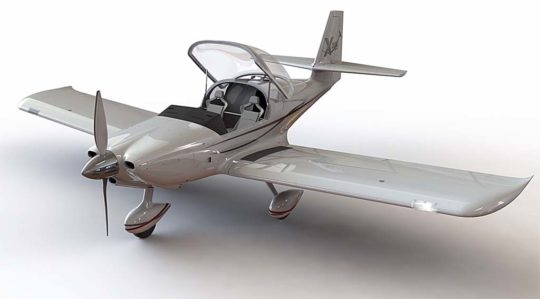 One is already approved and flying in the USA, Deon reported, using a slightly smaller Lycoming engine at present. Some 25 are presently flying in South Africa.
Whisper is, he added, "a fast and roomy aircraft, with a lower profile, making it about 10 knots faster than a RV 7."
One is already approved and flying in the USA, Deon reported, using a slightly smaller Lycoming engine at present. Some 25 are presently flying in South Africa.
Whisper is, he added, "a fast and roomy aircraft, with a lower profile, making it about 10 knots faster than a RV 7." 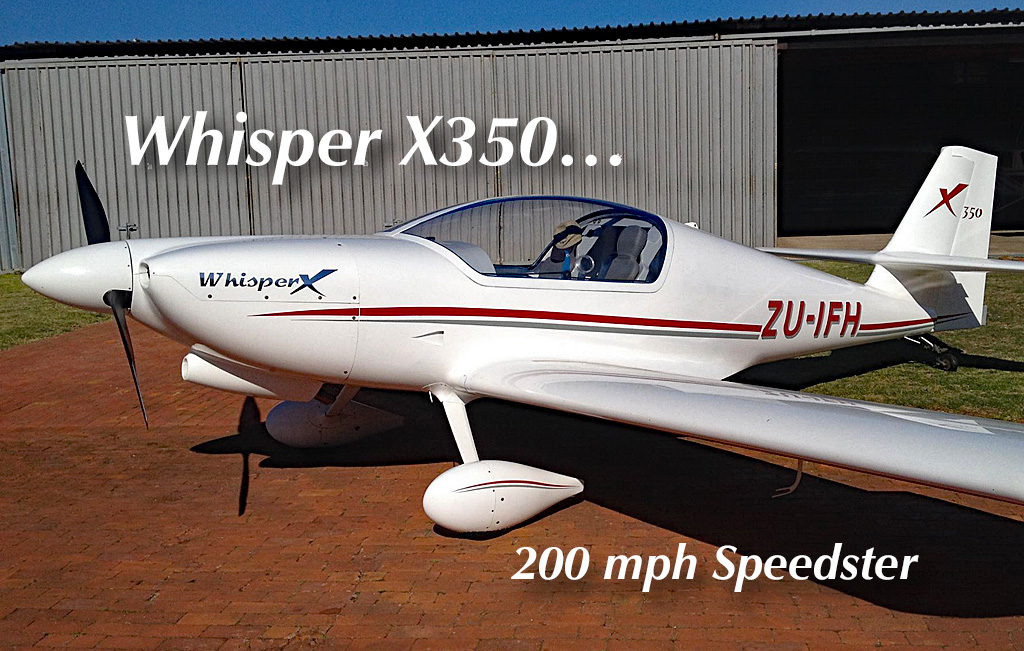
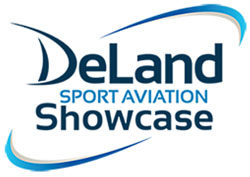 Fortunately, you can stay where it's warm and just watch — thanks to new videos from DeLand. While I missed my
Fortunately, you can stay where it's warm and just watch — thanks to new videos from DeLand. While I missed my 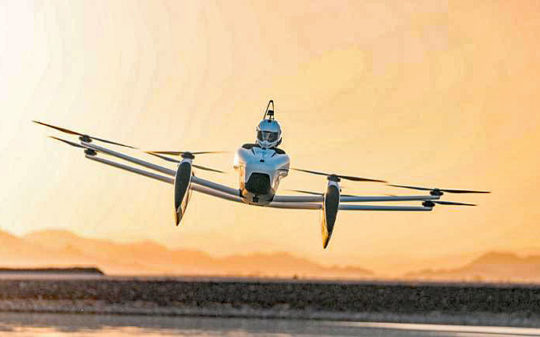 The following information and quotes come from a
The following information and quotes come from a 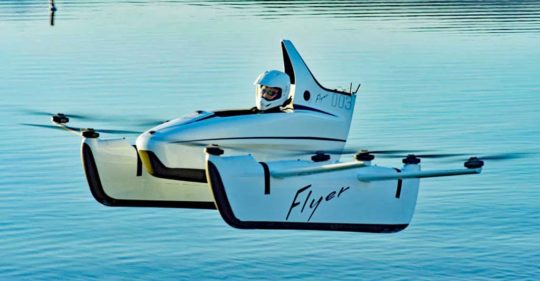
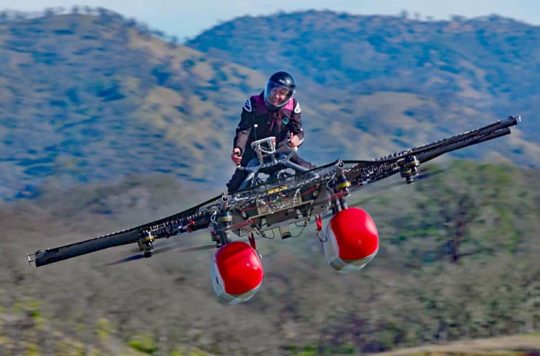
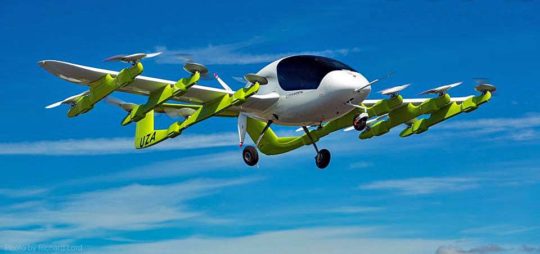
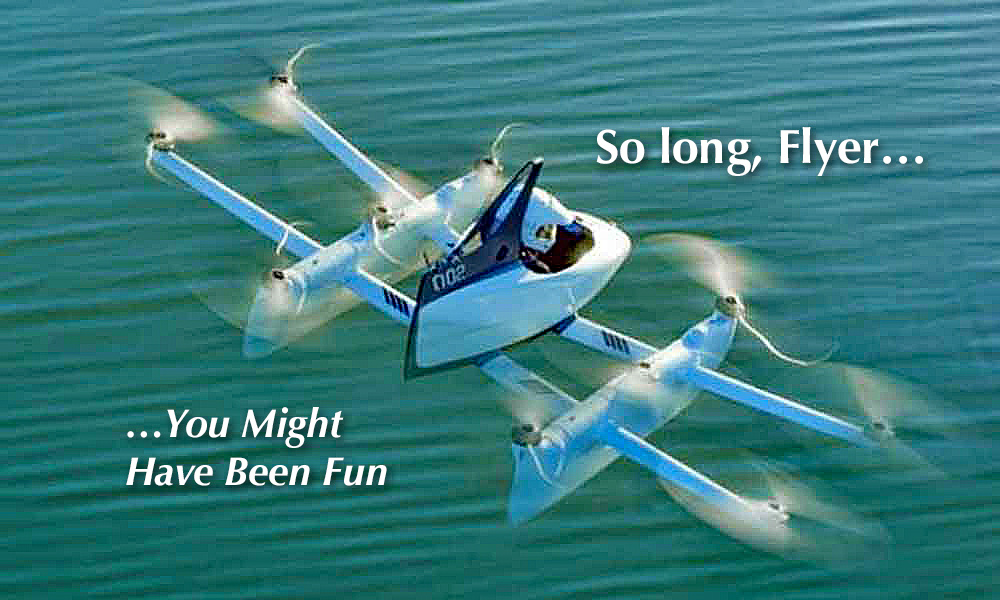
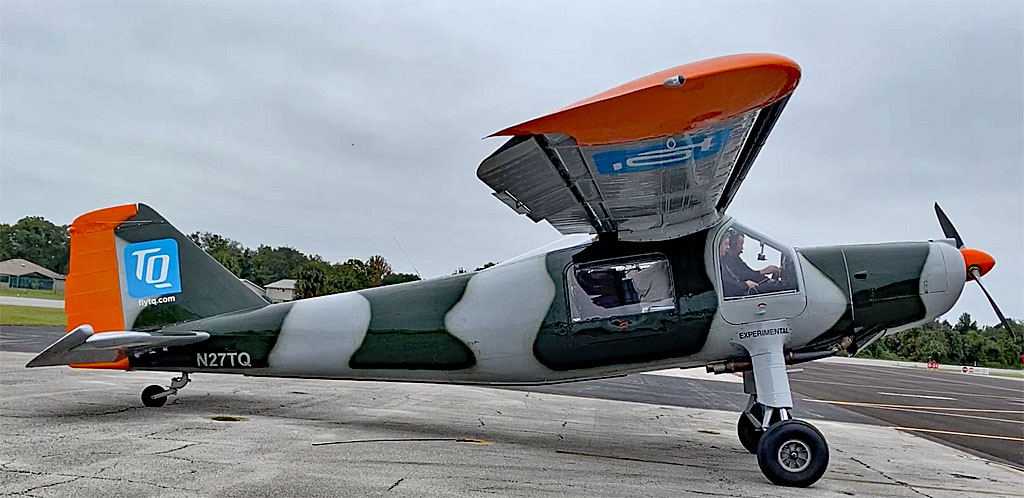 Regretfully, since DeLand closed and they flew the aircraft to its base, TQ bosses decided to sell the aircraft and are bringing Sebastian Glück back to Germany, leaving Daniel (Er-Jin) Jang to carry the TQ flag in America.
Regretfully, since DeLand closed and they flew the aircraft to its base, TQ bosses decided to sell the aircraft and are bringing Sebastian Glück back to Germany, leaving Daniel (Er-Jin) Jang to carry the TQ flag in America.
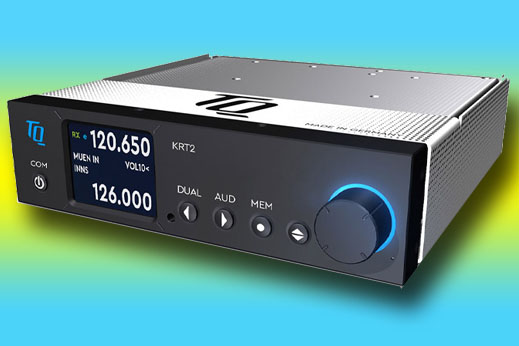 Learn about all TQ products at
Learn about all TQ products at 
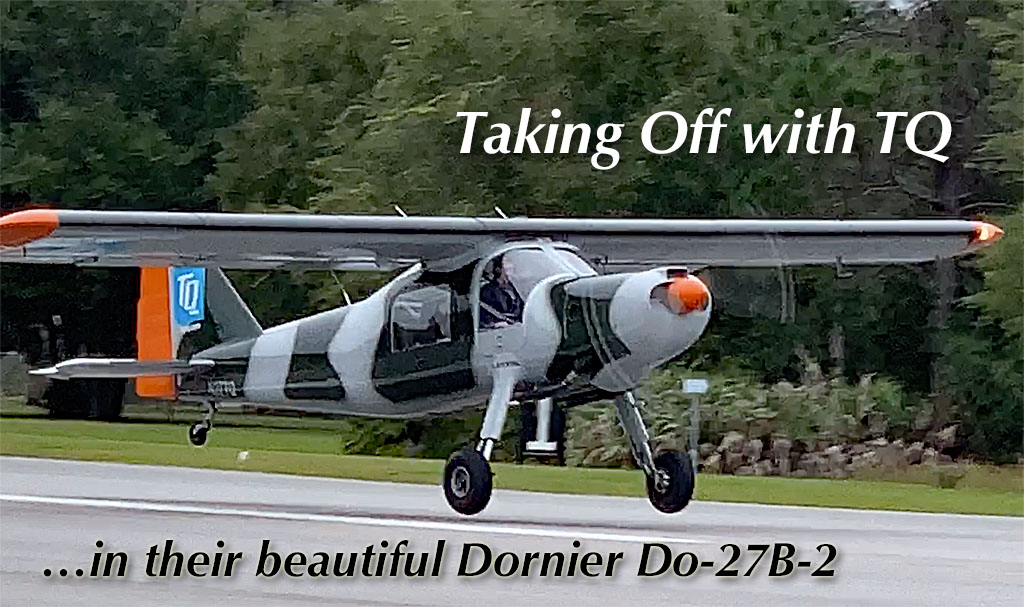
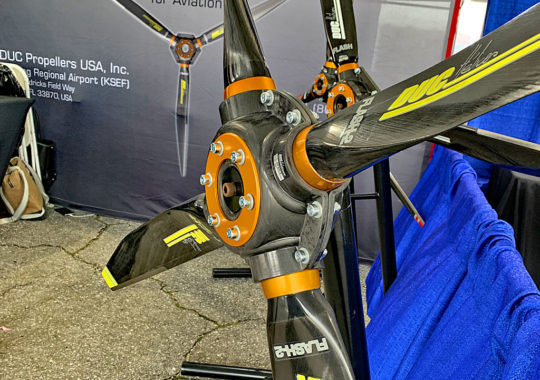 Visitors to the inside displays at Deland Showcase 2019 saw a new Flash 2 four-blade prop on display in the
Visitors to the inside displays at Deland Showcase 2019 saw a new Flash 2 four-blade prop on display in the 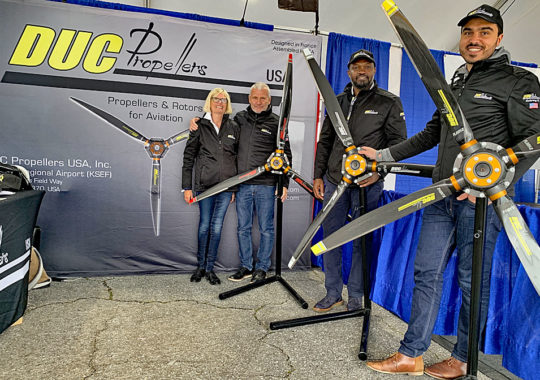
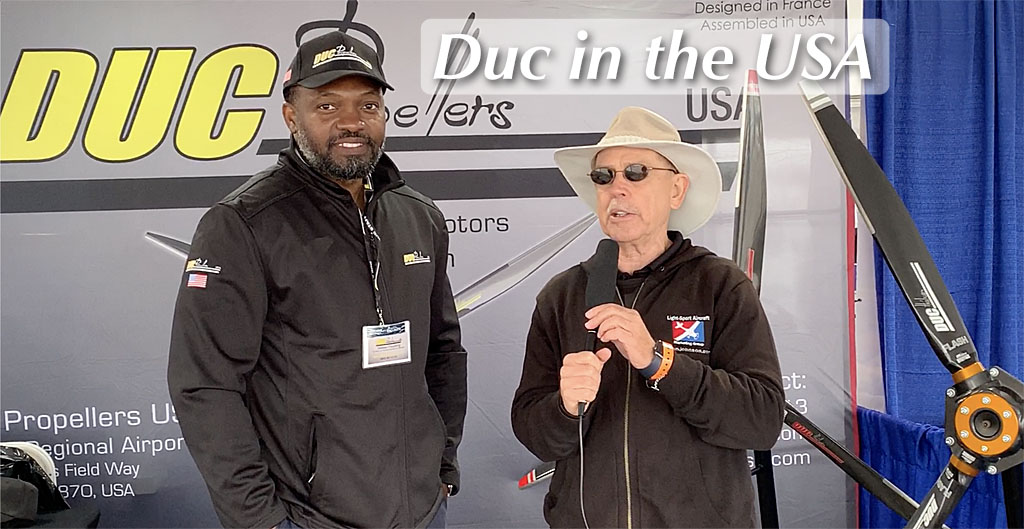

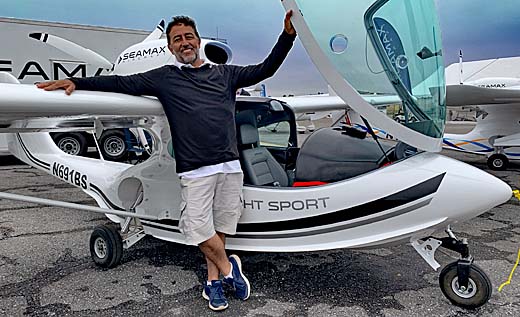
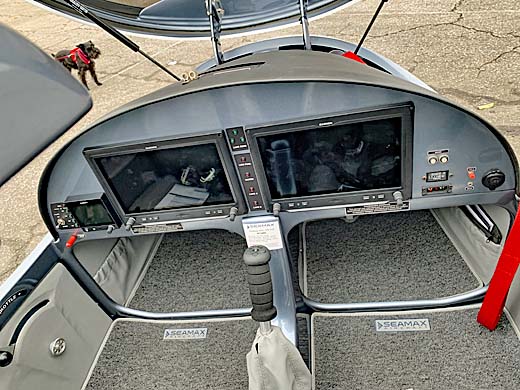
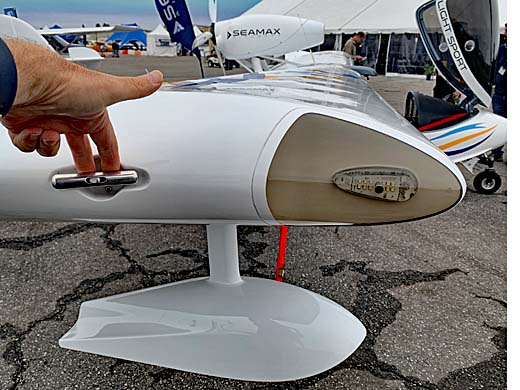
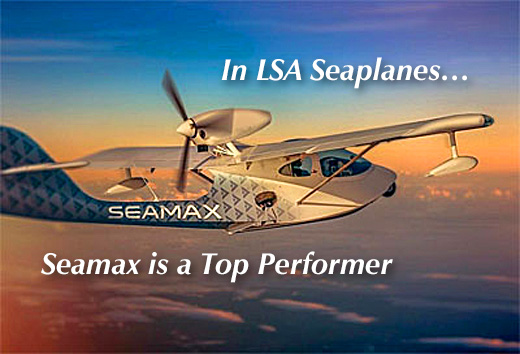


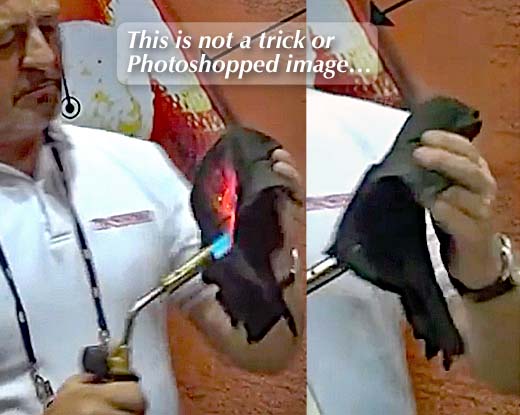
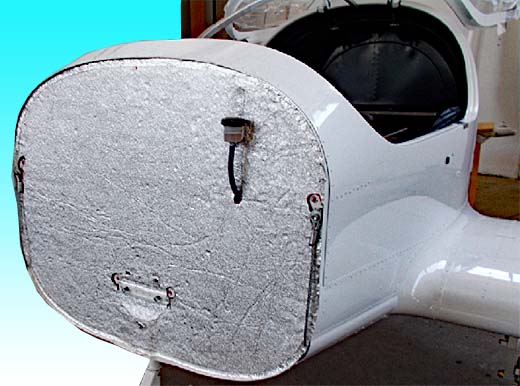
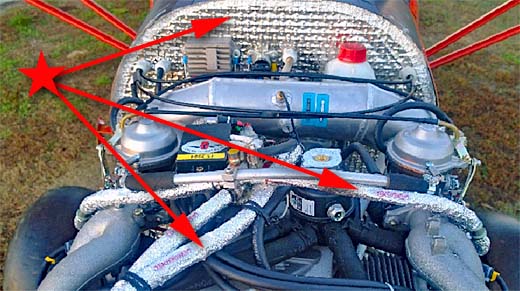

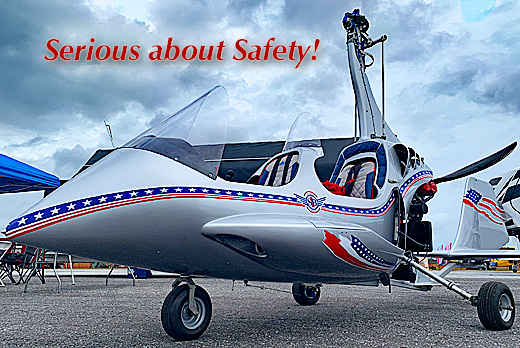
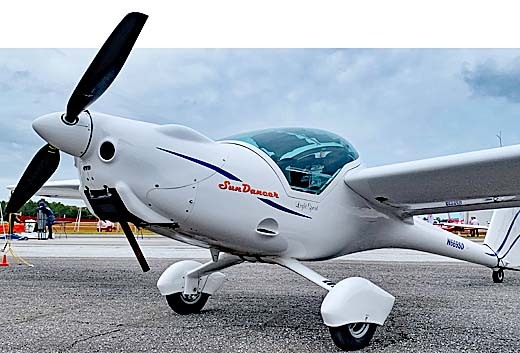 Opening day at
Opening day at 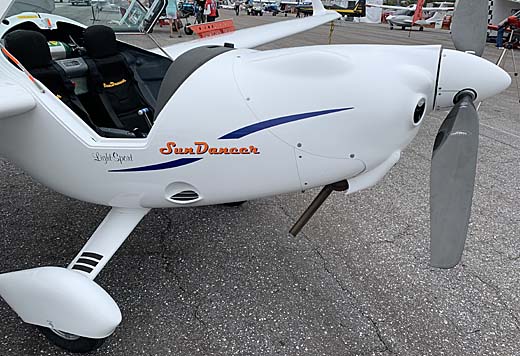 SunDancer may be consider two airplanes in one, partly as it can be either a very efficient and surprising speedy cruiser or a motorglider capable of genuine soaring flight, but also because it comes with two wing extensions. SunDancer motorglider can exchange removable wing extensions boosting wingspan from 42 feet 8 inches (13 meters) to 49 feet 2 inches (15 meters). Glide goes from a respectable 26:1 to 30:1.
If you've never thought about what that kind of reach means, try drawing a 30:1 line on a computer or graph paper (for reference, 1:1 is a 45° slope). If you're precise what you'll see looks essentially like a horizontal line. From 6,000 feet you can glide to almost any point you can see, presuming no wind resistance. Of course, this is also the reason why speed brakes are valuable; you'd be hard pressed to land on a long runway because SunDancer might keep gliding right past the end.
SunDancer may be consider two airplanes in one, partly as it can be either a very efficient and surprising speedy cruiser or a motorglider capable of genuine soaring flight, but also because it comes with two wing extensions. SunDancer motorglider can exchange removable wing extensions boosting wingspan from 42 feet 8 inches (13 meters) to 49 feet 2 inches (15 meters). Glide goes from a respectable 26:1 to 30:1.
If you've never thought about what that kind of reach means, try drawing a 30:1 line on a computer or graph paper (for reference, 1:1 is a 45° slope). If you're precise what you'll see looks essentially like a horizontal line. From 6,000 feet you can glide to almost any point you can see, presuming no wind resistance. Of course, this is also the reason why speed brakes are valuable; you'd be hard pressed to land on a long runway because SunDancer might keep gliding right past the end.
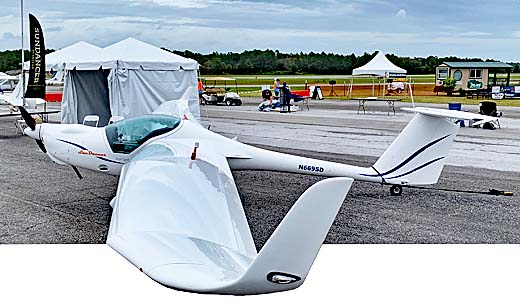 Clearly, cruising from the West Coast to East Coast shows SunDancer to be a serious travel machine for two occupants. Tomazin said you can range 800 miles and carry 100 pounds of baggage.
SunDancer grosses at 1,320 pounds like most LSA but has a fairly light empty weight of 639 pounds. It is powered by either the 80- or 100-horsepower Rotax 912.
Clearly, cruising from the West Coast to East Coast shows SunDancer to be a serious travel machine for two occupants. Tomazin said you can range 800 miles and carry 100 pounds of baggage.
SunDancer grosses at 1,320 pounds like most LSA but has a fairly light empty weight of 639 pounds. It is powered by either the 80- or 100-horsepower Rotax 912.
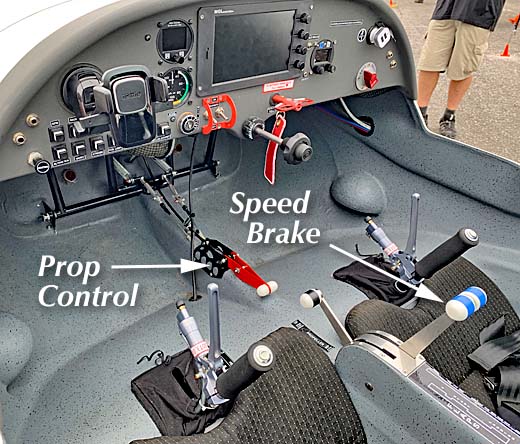 According to FAA Part 61.23, "A person is not required to hold a medical certificate … when exercising the privileges of a Sport Pilot certificate with privileges in a glider or balloon," with the definition of a glider being "…a heavier-than-air aircraft, that is supported in flight by the dynamic reaction of the air against its lifting surfaces and whose free flight does not depend principally on an engine." SunDancer easily qualifies.
Here's further motorglider advice compliments of Jim Hanson writing for our friends at Midwest Flyer (
According to FAA Part 61.23, "A person is not required to hold a medical certificate … when exercising the privileges of a Sport Pilot certificate with privileges in a glider or balloon," with the definition of a glider being "…a heavier-than-air aircraft, that is supported in flight by the dynamic reaction of the air against its lifting surfaces and whose free flight does not depend principally on an engine." SunDancer easily qualifies.
Here's further motorglider advice compliments of Jim Hanson writing for our friends at Midwest Flyer (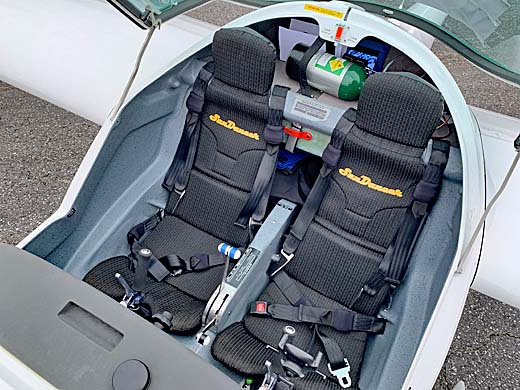 "With their large wing area, [motorgliders] offer low stall speeds, fast climb, and near-STOL capabilities. They usually employ glider-like spoilers or airbrakes for direct lift control and steep descents." Speed brakes offer both dramatic and precise lift control despite their relatively small size; one secret is the exact placement on the wing's chord. Their power and usefulness prompted Hanson to add, "Once you fly an aircraft with spoilers, you’ll wonder why every airplane doesn’t have them."
No question, motor gliders have their intriguing qualities and might deserve serious attention. Priced quite reasonably (definitely so compared to motor gliders like a Stemme S-12), SunDancer is a good value at around $135,000.
Here's a short video recorded at DeLand Showcase 2019. A more detailed video will follow later.
"With their large wing area, [motorgliders] offer low stall speeds, fast climb, and near-STOL capabilities. They usually employ glider-like spoilers or airbrakes for direct lift control and steep descents." Speed brakes offer both dramatic and precise lift control despite their relatively small size; one secret is the exact placement on the wing's chord. Their power and usefulness prompted Hanson to add, "Once you fly an aircraft with spoilers, you’ll wonder why every airplane doesn’t have them."
No question, motor gliders have their intriguing qualities and might deserve serious attention. Priced quite reasonably (definitely so compared to motor gliders like a Stemme S-12), SunDancer is a good value at around $135,000.
Here's a short video recorded at DeLand Showcase 2019. A more detailed video will follow later.
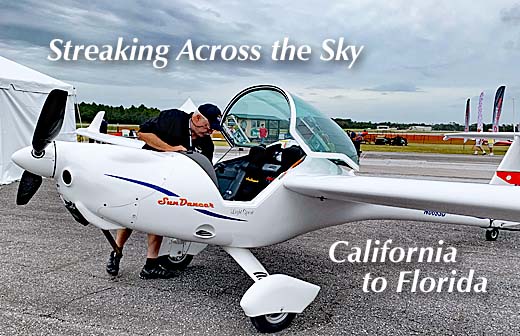
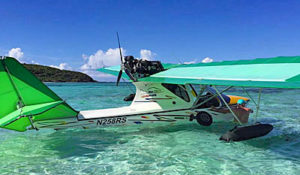 You can relax, though. It should warm up to more respectable temperatures as the show starts and continues. So this seems like a great time to attend the
You can relax, though. It should warm up to more respectable temperatures as the show starts and continues. So this seems like a great time to attend the 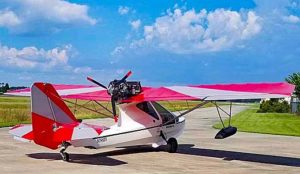 However, I have inquired on several occasions to learn an Aventura kit can get airborne for just over $50,000. The base airframe kit is less than $40,000 and you have several engine options including
However, I have inquired on several occasions to learn an Aventura kit can get airborne for just over $50,000. The base airframe kit is less than $40,000 and you have several engine options including 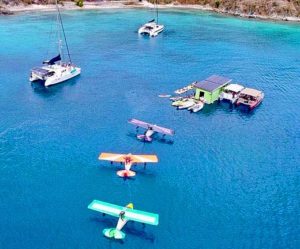
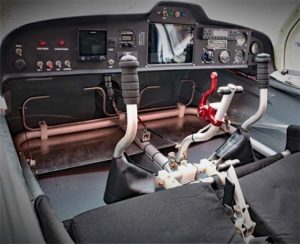 "Only basic shop tools are required and an assembly manual is provided with clear crisp details of each assembly," added Walstrom. "The airframe is aluminum (the structural part of the aircraft) and the hull is made from fiberglass (which simply provides flotation). All hardware and everything required to assemble the kit is included. All of the aluminum is anodized (inside and out) to maximize corrosion protection from the elements."
"Only basic shop tools are required and an assembly manual is provided with clear crisp details of each assembly," added Walstrom. "The airframe is aluminum (the structural part of the aircraft) and the hull is made from fiberglass (which simply provides flotation). All hardware and everything required to assemble the kit is included. All of the aluminum is anodized (inside and out) to maximize corrosion protection from the elements."
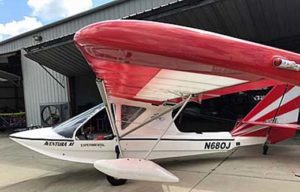 Walstrom further glowed, "These aircraft are capable of taking off and landing in less than 250 feet!"
In Florida or other suitable climates, Aventura's open-sided cockpit lets the wind whistle through your hair while you rest your arm on the window sill. Retractable landing gear is standard; it’s mechanically actuated or an electric linear actuator is available as an option.
Learn more by attending
Walstrom further glowed, "These aircraft are capable of taking off and landing in less than 250 feet!"
In Florida or other suitable climates, Aventura's open-sided cockpit lets the wind whistle through your hair while you rest your arm on the window sill. Retractable landing gear is standard; it’s mechanically actuated or an electric linear actuator is available as an option.
Learn more by attending 